Either you get it, or you don’t! Thanks to “Siegfried & Joy”!
Author: Admin
The Bathers of Inishmore
Inspired by the tragicomic – but oh so beautiful – film ‘The Banshees of Inisherin‘ we spent our Easter Holidays in Ireland this year. Inisherin is a fictional island, filmed partly on The Aran Islands at the mouth of Galway Bay on the west coast of Ireland. The name Inisherin can be translated from Gaelic to ‘The Island of Ireland‘. It doesn’t get more Irish than that!
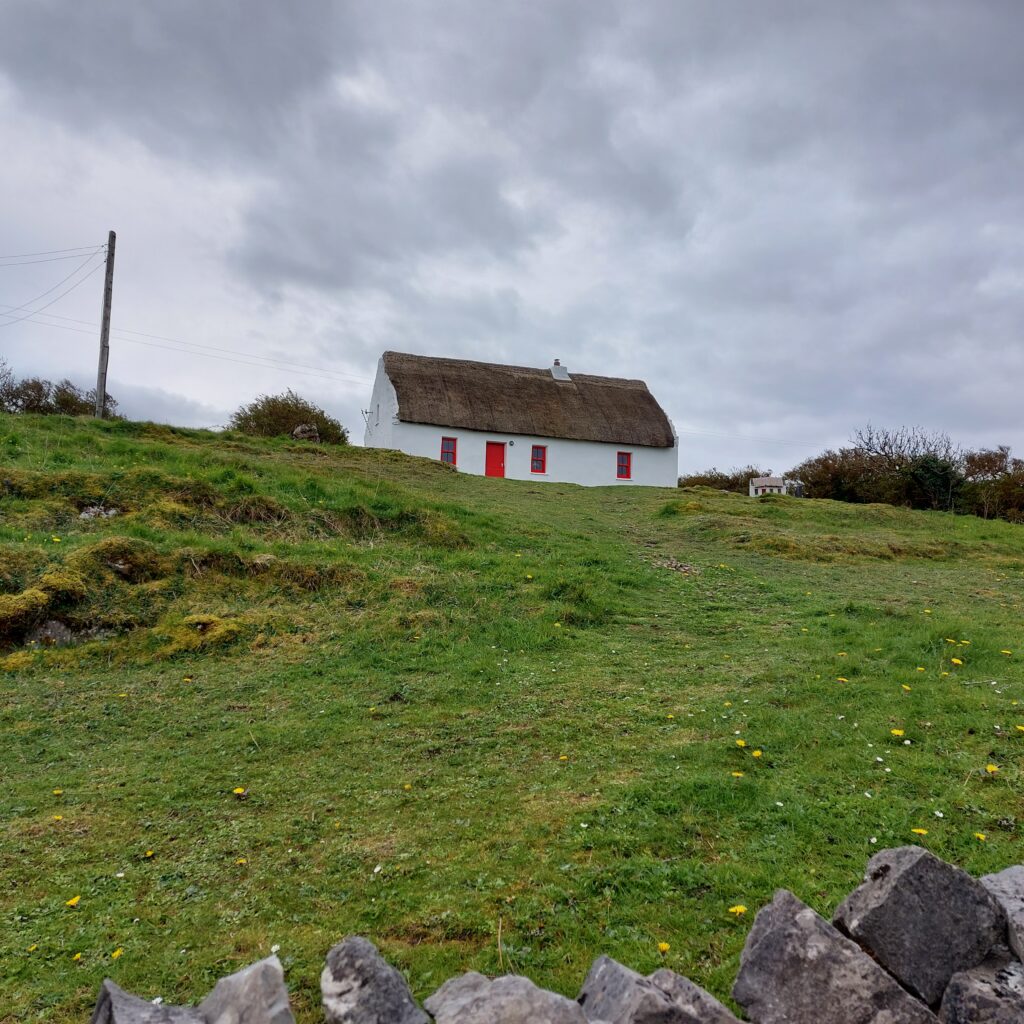
The Aran Islands consist of 3 islands: Inishmore (the largest island), Inishmaan (the middle island) and Inisheer (the easternmost island). The latter is also the smallest. The highest number of residents was 3,500 around 1840. Today’s population is just under 1,500, of which just over half live in Inishmore. However, the number is steadily decreasing, and that is easy to observe.
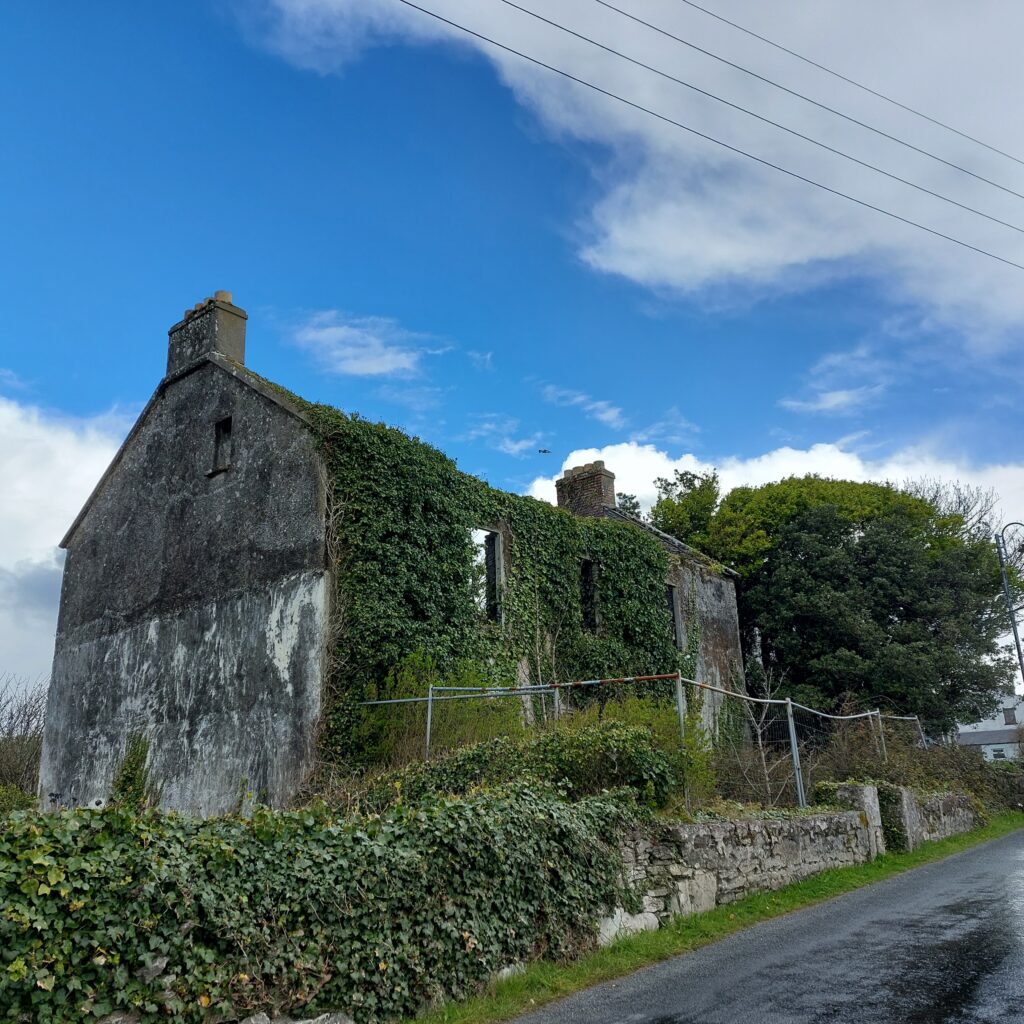
The islands were inhabited thousands of years ago, and at that time they had little or no soil at all. The agricultural landscape has been painstakingly built up by humans. Seaweed and kelp was collected from the sea, mixed with sand and then the soil was protected with stone fences.
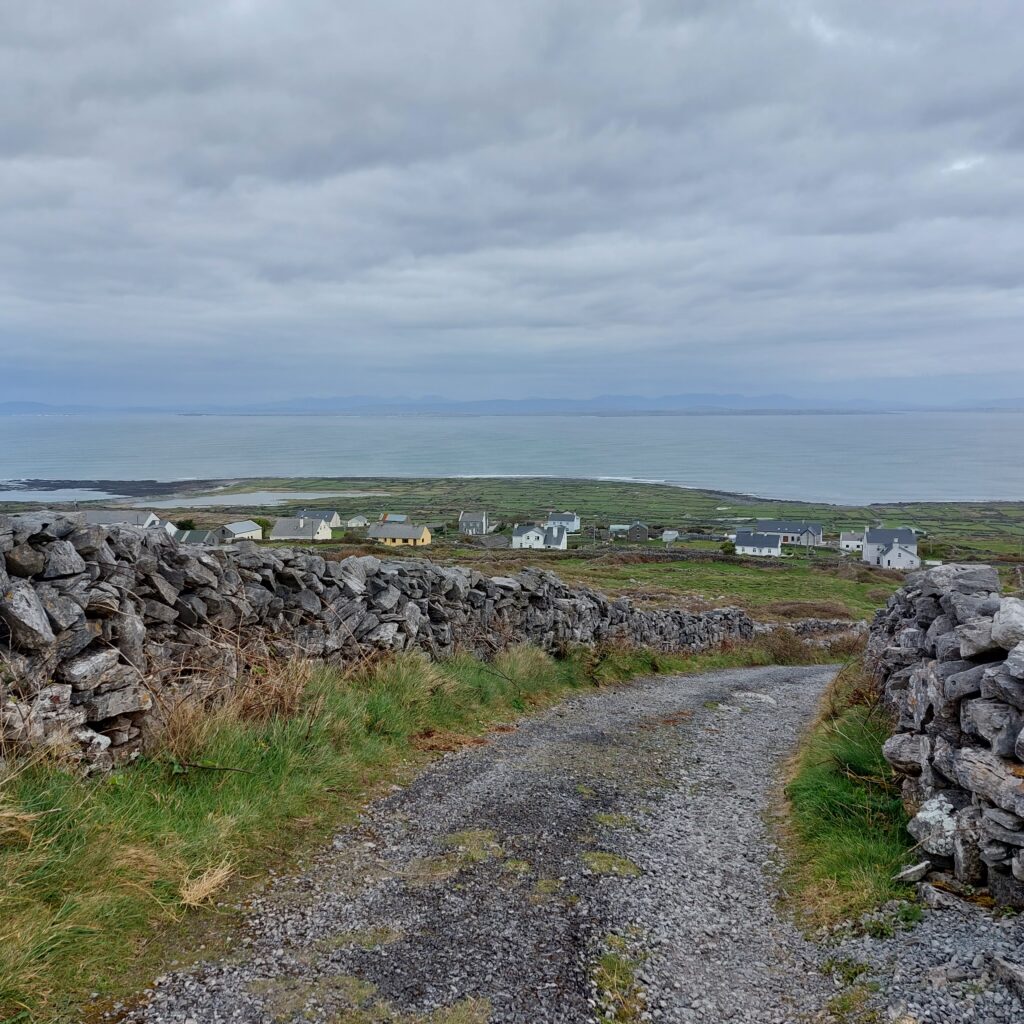
Here, Irish is spoken everywhere, and notices and signs are not always translated into English. Many ‘mainland’ Irishmen spend the weekend here, as many as 1,000 day-trippers in the summer season. But as soon as the last boat has left (around four o’clock), it all calms down and you quickly get in contact with the locals, who really like you spending the night on the islands. With one big BUT: The exception is hen/stag parties! The description when we booked the room was that all bachelor parties will be refused entry, they will not get anything refunded and end up having major problems finding other accommodation, since the islanders notify each other! Except that, the inhabitants are very friendly and helpful.
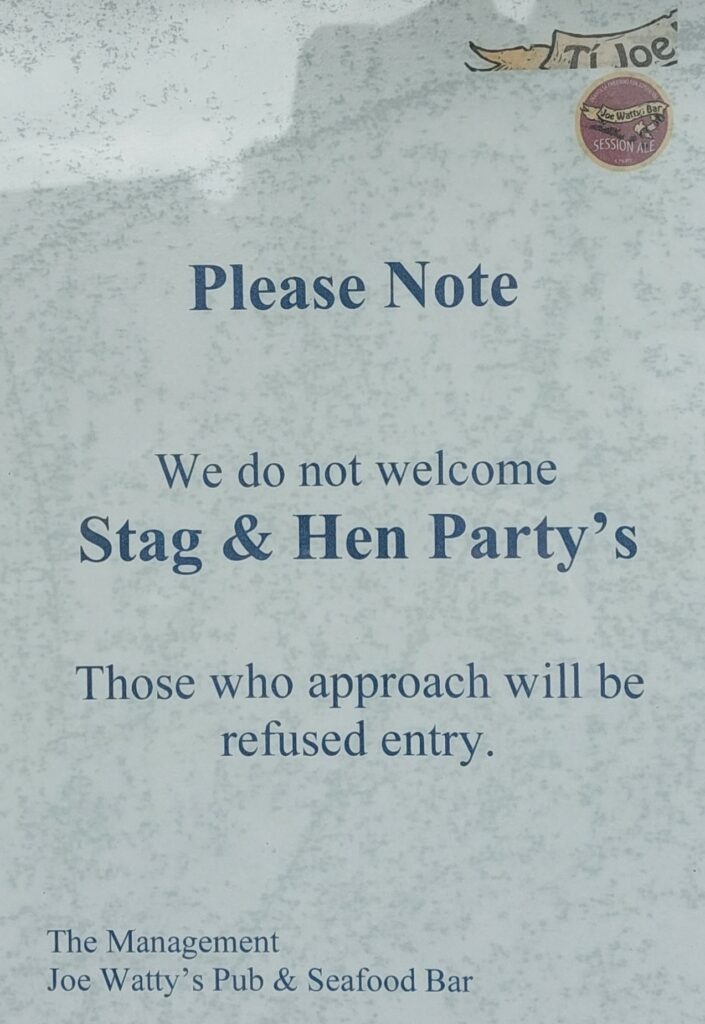
We took the boat from Galway to Inishmore and stayed a couple of nights. A fascinating place! Business today is based on tourism, and when you get off the boat you are greeted by an army of taxis, minibuses and horse-drawn carriages offering rides around the island. We rented bikes instead, we think that’s the absolute best way to discover the place.
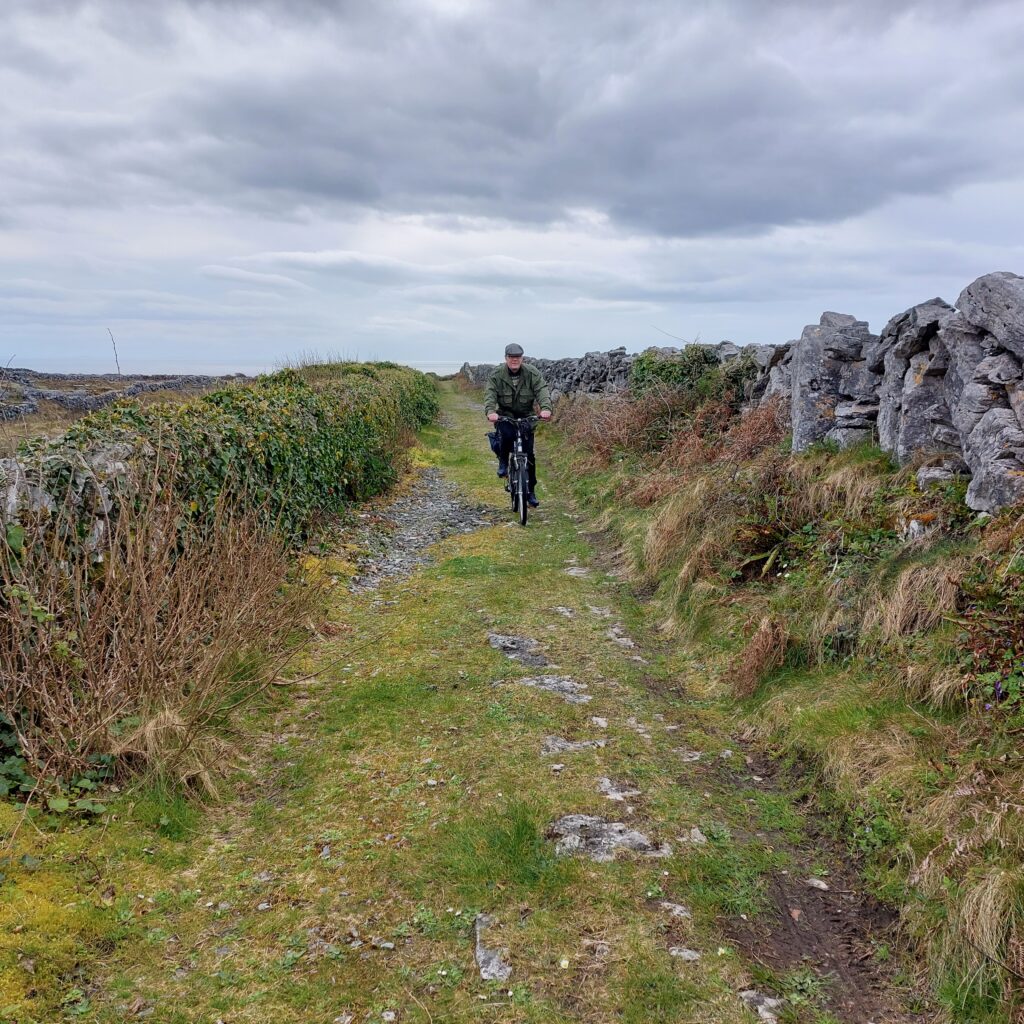
The weather on the islands is stably unstable, you can expect a good mixture of wind, rain and sunshine every day. The average temperature is between +6 degrees in January and +15 in July. The flora of the islands is therefore a blend of arctic, alpine and Mediterranean flora, with a growing season that lasts almost the whole year.
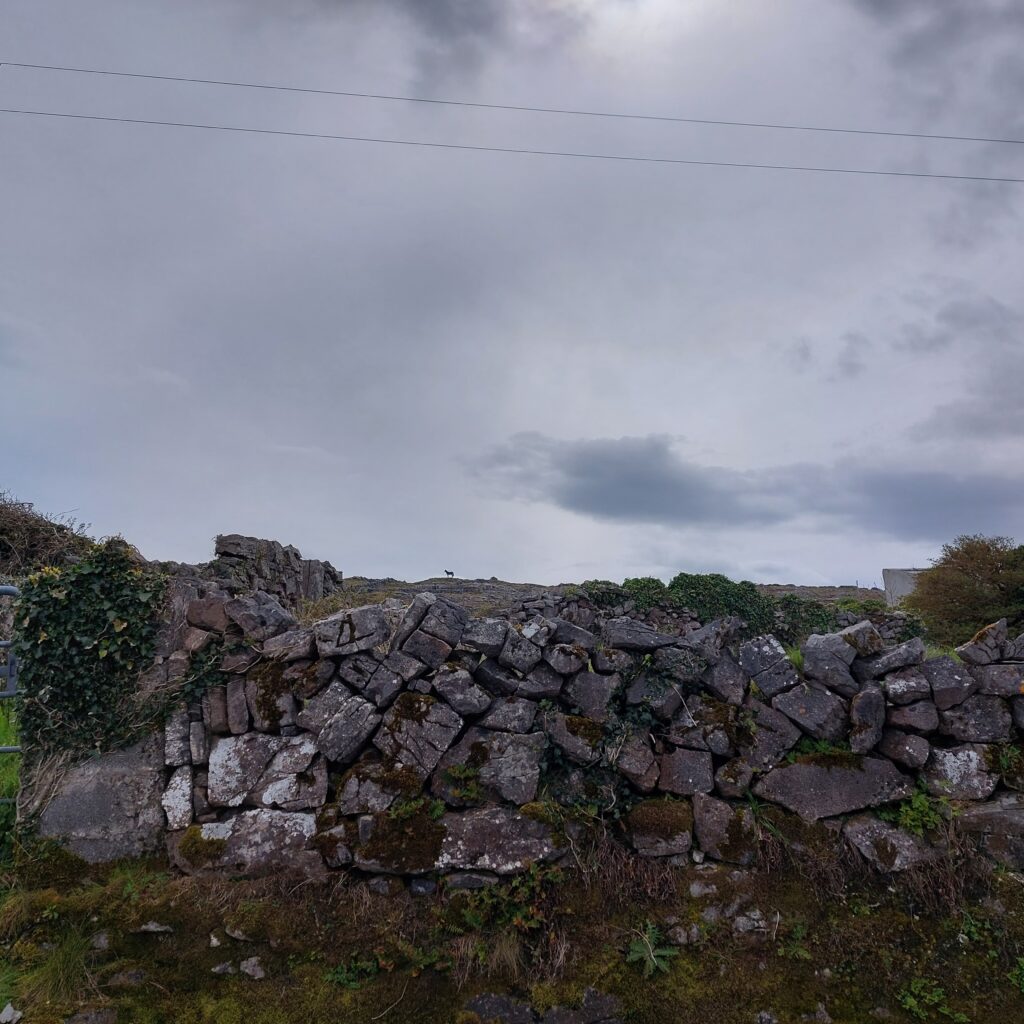
The east side of Inishmore is a quite friendly lowland with white beaches and seal colonies. It’s nice to swim here! In fact, you don’t have to go many meters away from the quay in Kilronan for a swim, the bay has several nice, sheltered beaches with beautiful, clear water.
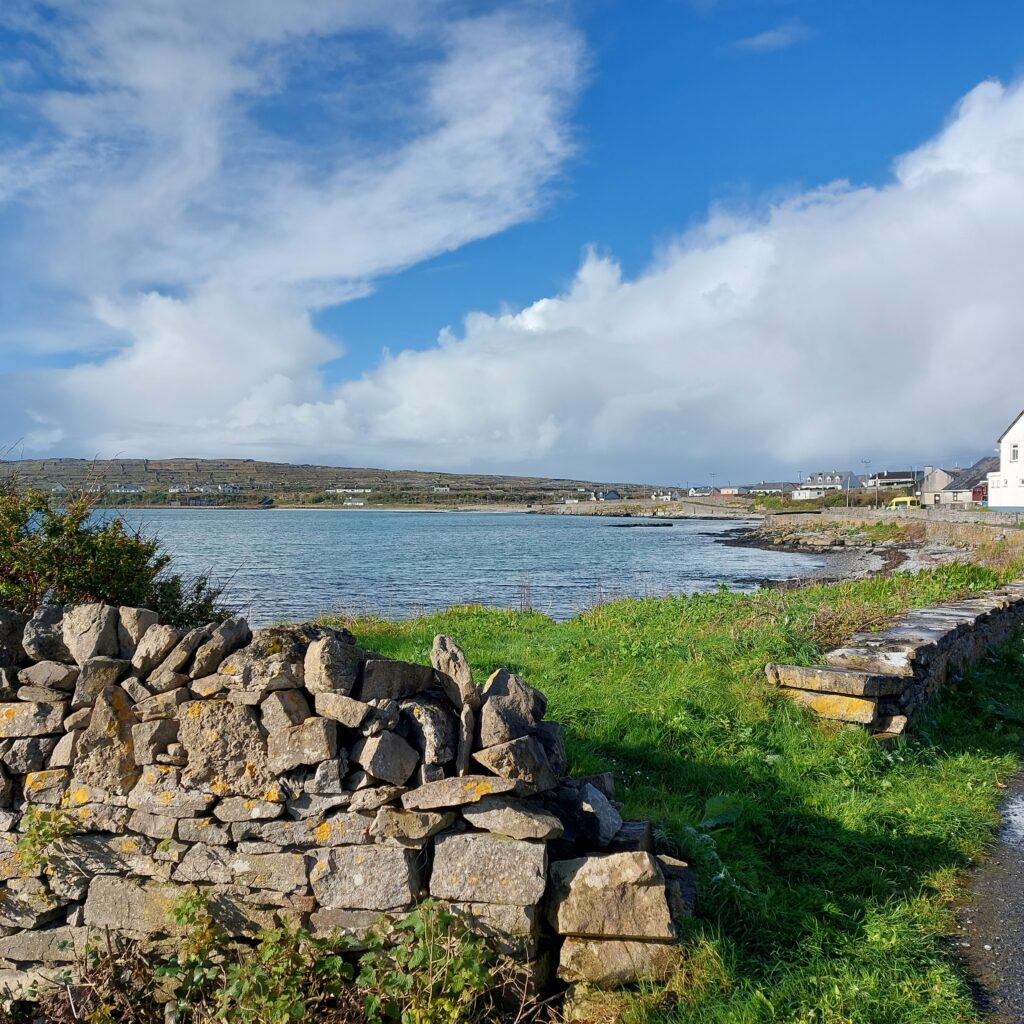
According to our gentle hostess, this is where the children at Inishmore learn to swim. A bit unpleasant, though, when you get ‘that quicksand feeling‘ on the way out.
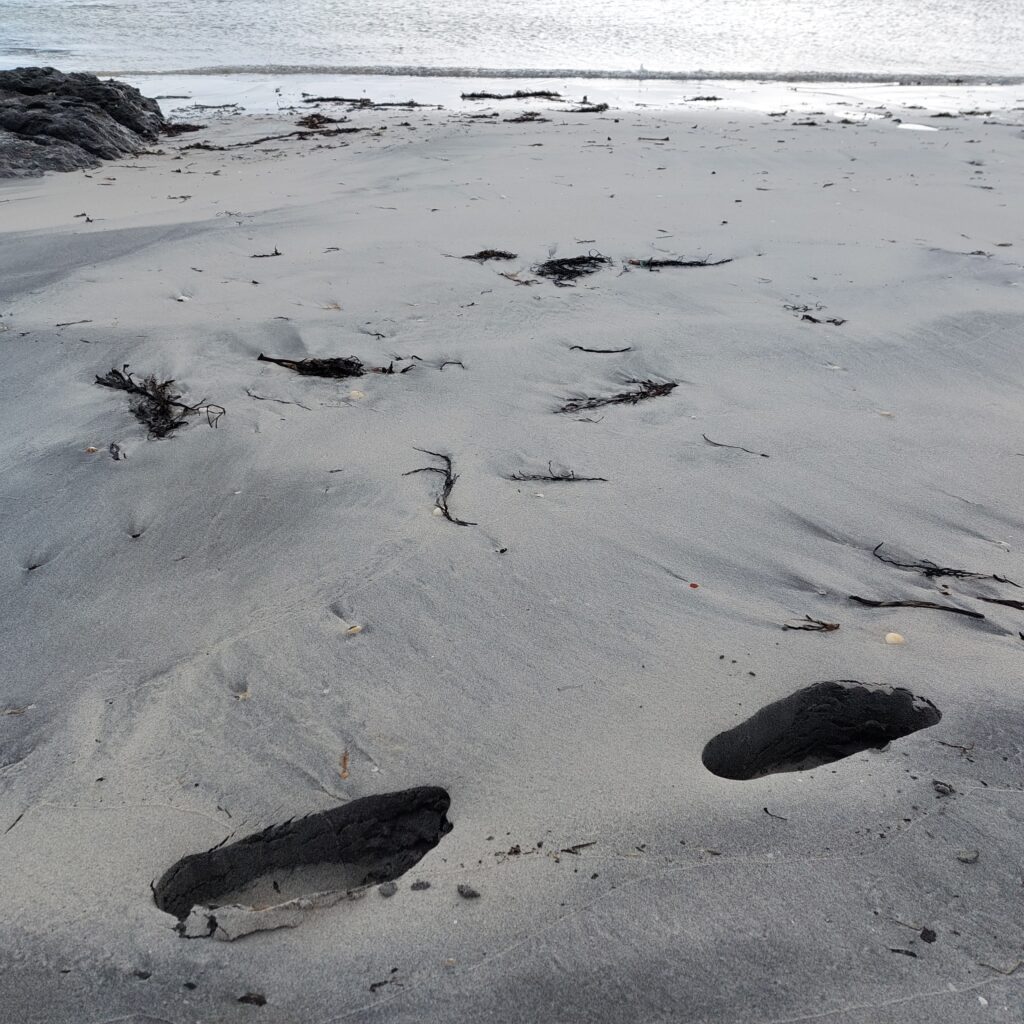
Nevertheless, we got an excellent Easter morning swim at Inishmore! A number of cars drove past extremely slowly in the background of the bathing beach, so it’s probably not common to bathe at Easter time. But great for us, as often before, we had the beach to ourselves.
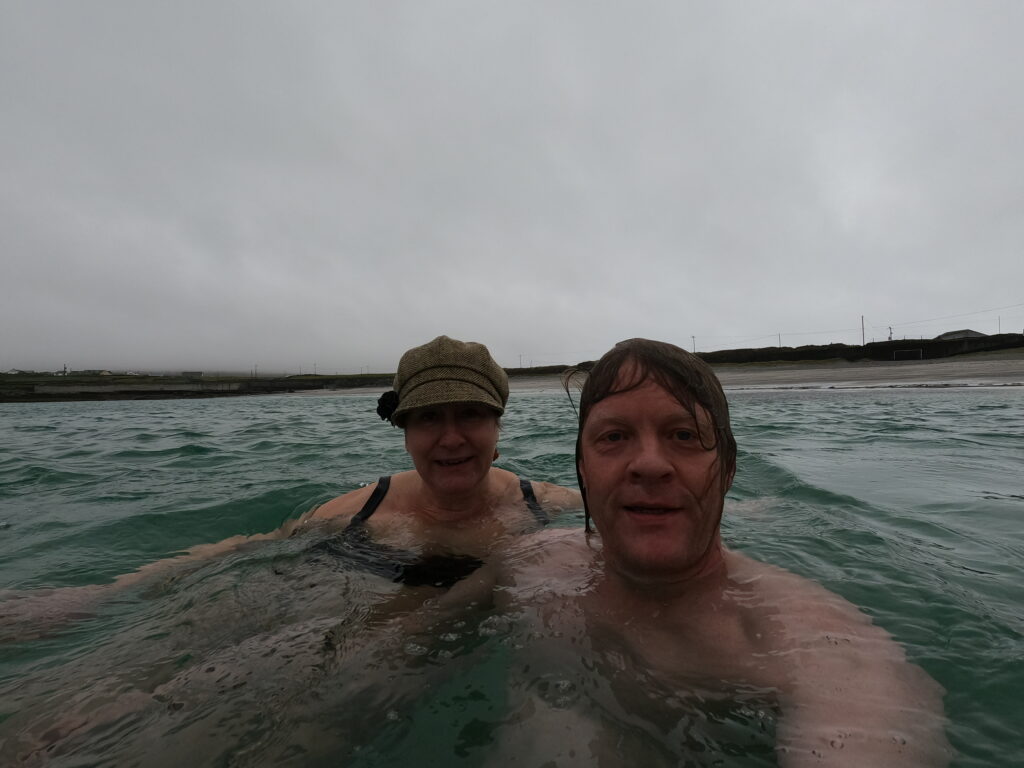
What we didn’t do at Inishmore was having a dive in the 50 m deep ‘Wormhole’. The west side of the island consists of high limestone cliffs. Here the sea hits with great force, there is nothing that slows down during the 3000 km of Atlantic Ocean between New Foundland and Inishmore.
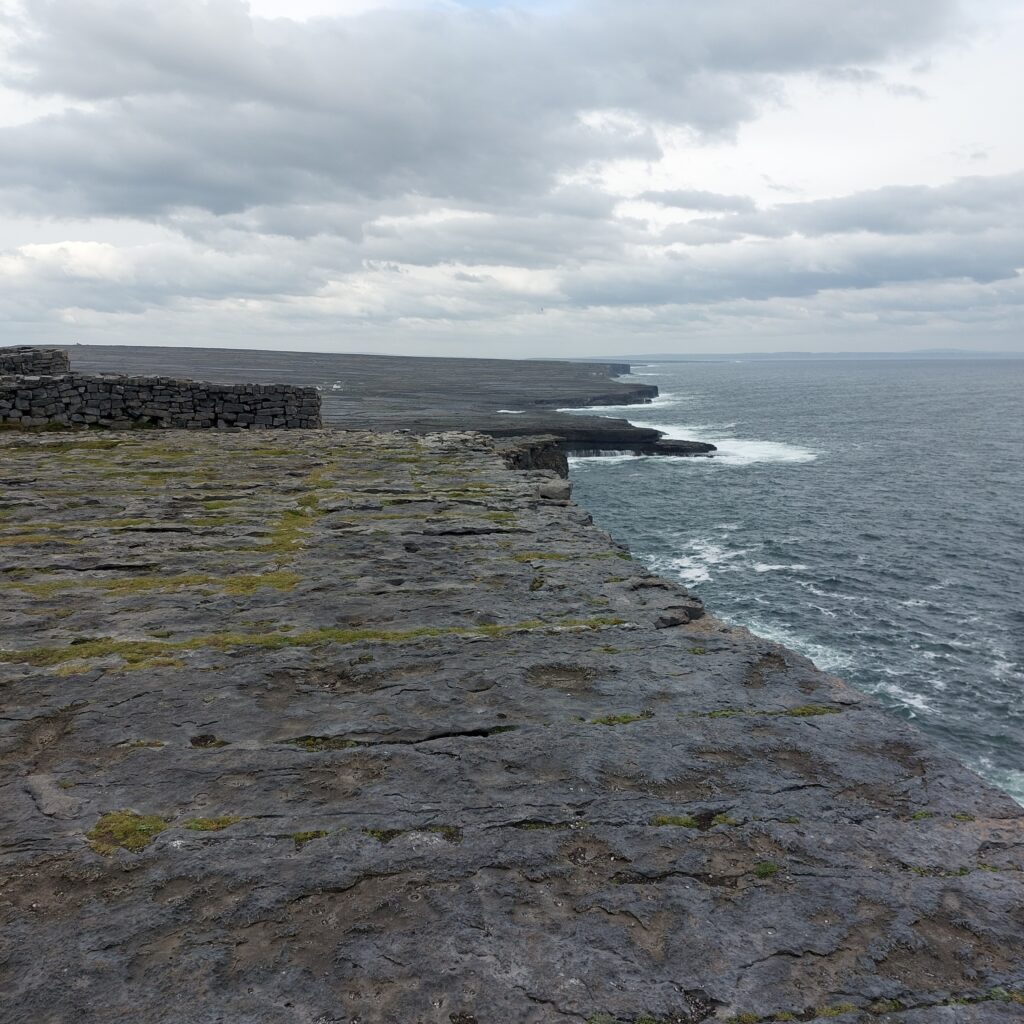
Based on the description, we thought that ‘Yes! We have to try this!’. … but quickly realized that it was just not the right thing to do, under the current circumstances!
There have been cliff diving competitions here twice (2014 and 2017), but after all the scaffolding and ramps were washed into the sea during another attempt later, it is agreed not to arrange any more such events here in the immediate future.
There are swimming pictures on net from the Wormhole and it is probably not very dangerous if the tide and the weather cooperate. And if you have a plan for how to get back up! But unfortunately, every now and then, they have to pick up someone who died here.
After a trip to the Wormhole, a pub visit is just right. And what could be better than enjoying an Aran Island Gin? Flavored with kelp harvested on ‘The Aran Islands’, it has lots of umami. And the taste? It tastes what it is flavored with…
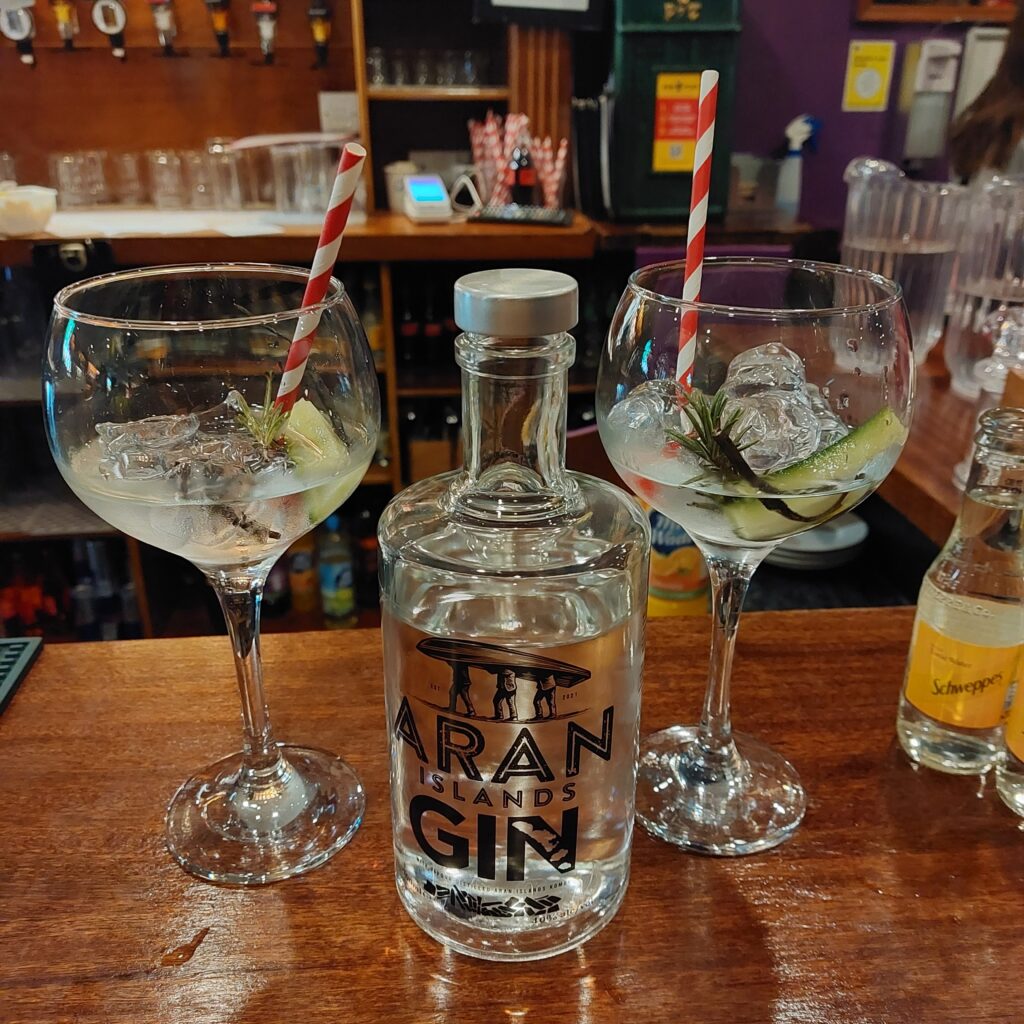
The Summer Islands
From the tax registers you can read that there were 3 farms registered on the Summer Islands outside Helsinki in 1570: Stor-Svinö (Big Pig Island), Lill-Svinö (Small Pig Island) and Moisö (?). The farms where richer than average, partly because they were allowed to pay their taxes with oil from seal.
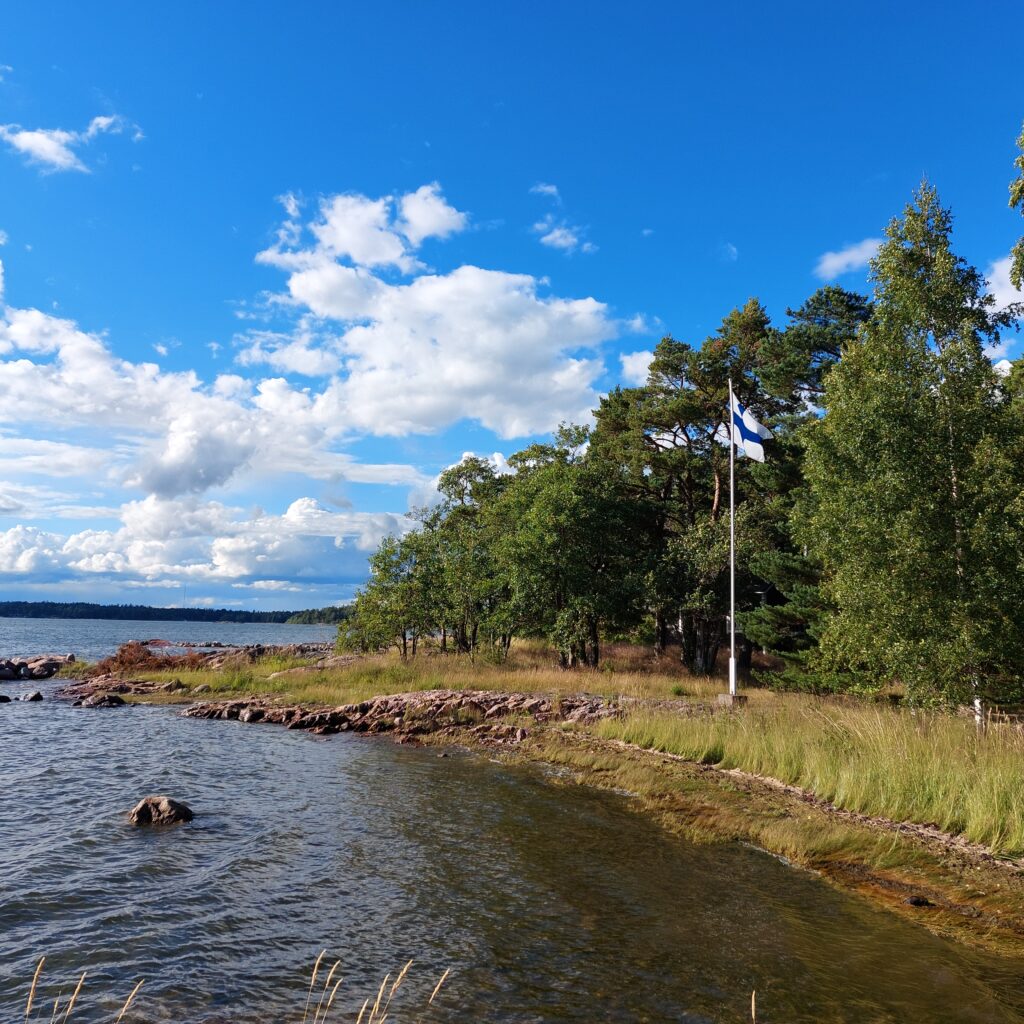
The big turnover came in the alcohol prohibition period (1919-1932), when the population on the Summer Islands had a suspiciously higher income than average people. Some of the money was invested in big villas, which where rented to rich Helsinki residents at summer time. The guests where shipped to the islands with steam boats. In the 1950’s there where around 50 households on the Summer Islands. All except 2 where Swedish speaking. Today there live around 570 people on the islands and the Finnish-Swedish percentage is down to 35 %. Finland as a whole had around 17 % Swedish speaking in the 1600’s. Today there are only around 5 %, partly because of emigration to Sweden.

We were in Finland to celebrate our friend Peter’s 60-years anniversary. Peter has (several) cottages on the Island Stora Lövö. Idun finds it rather amusing that she (Løwø) and the island have the same name. Maybe not so strange, since Lövö can be interpreted as “Leaf Island”. Maybe the island has its named because it is so thin (like a leaf). Fun nonetheless.

The day before the anniversary there was a rock ‘n roll party at Esbo Segelförening (ESF) on the island Pentala. We just had to join in!

We managed to book a dinner table, but having lunch so late that we couldn’t eat when we came! So we had to make up by dancing and bringing the spirits up.

After a great time with dancing and buckets of sweat, a bath is a very good idea. Our luggage had been left at Oslo Airport, so we had to make due without swimming gear. But that wasn’t really a problem. A great bath at sundawn.
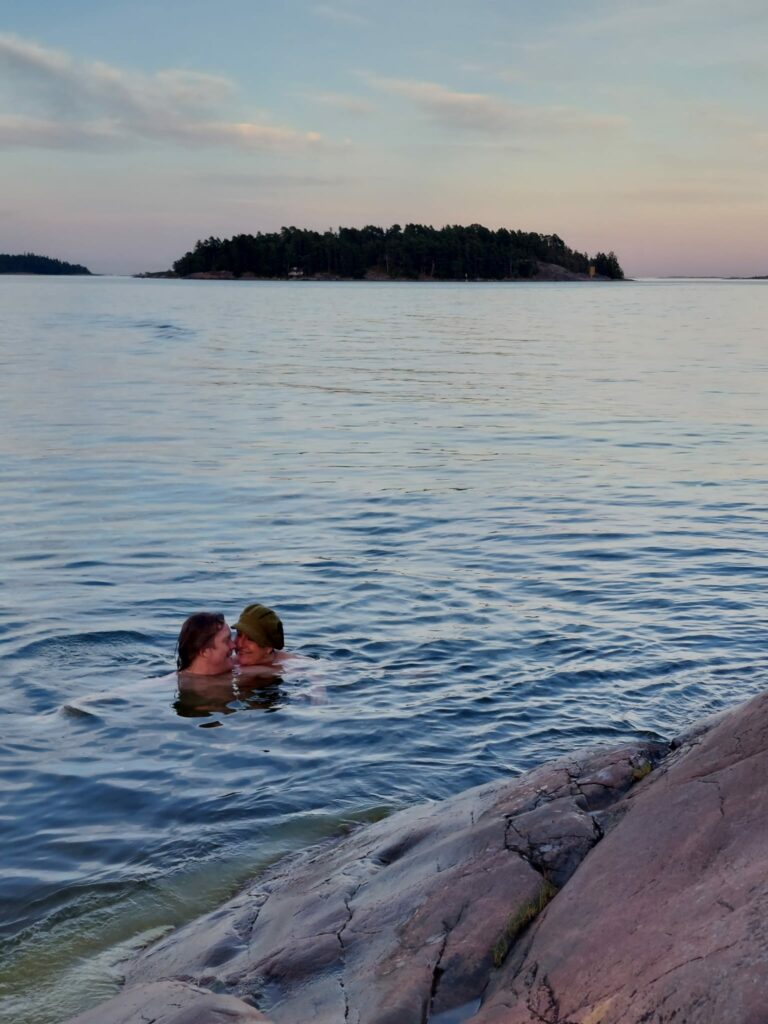
And the luggage? Nicely placed by the garbage container on Bodö, to be picked up after the dancing. Strangely enough, Finnair didn’t deliver directly to any island, but we were still happy. Last time we were on the Summer Islands in a 60-years anniversary (11 years ago), we got our luggage on return to Trondheim! And that party was of type tuxedo. A little embarrassing walking around in T-shirt and shorts…
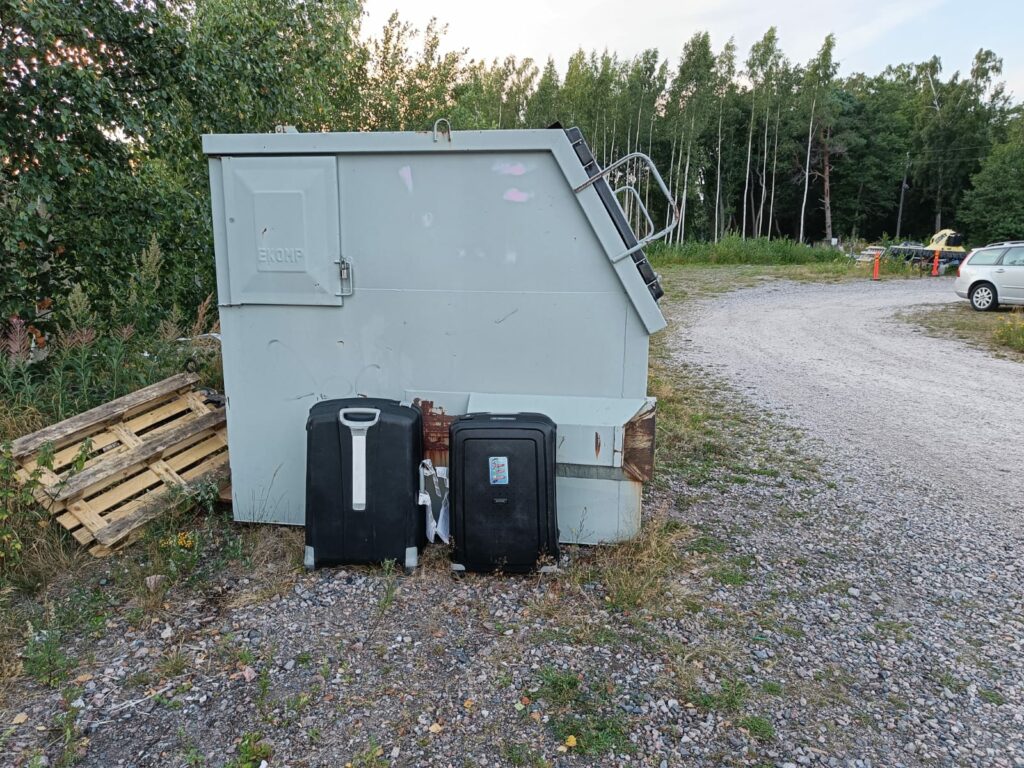
The Merman
We were in Copenhagen at the end of june. Where we could witness the celebration of ‘Studenten’. While in Norway we have “russefeiring” which lasts a long time, this is supposedly a one day celebration (although we saw students partying all the weekend). The class hires one car where they can stand on the truck bed and party and drive around to all parents. All these cars stop on Højbro Plads. Accidents happen – some got the party cut short.
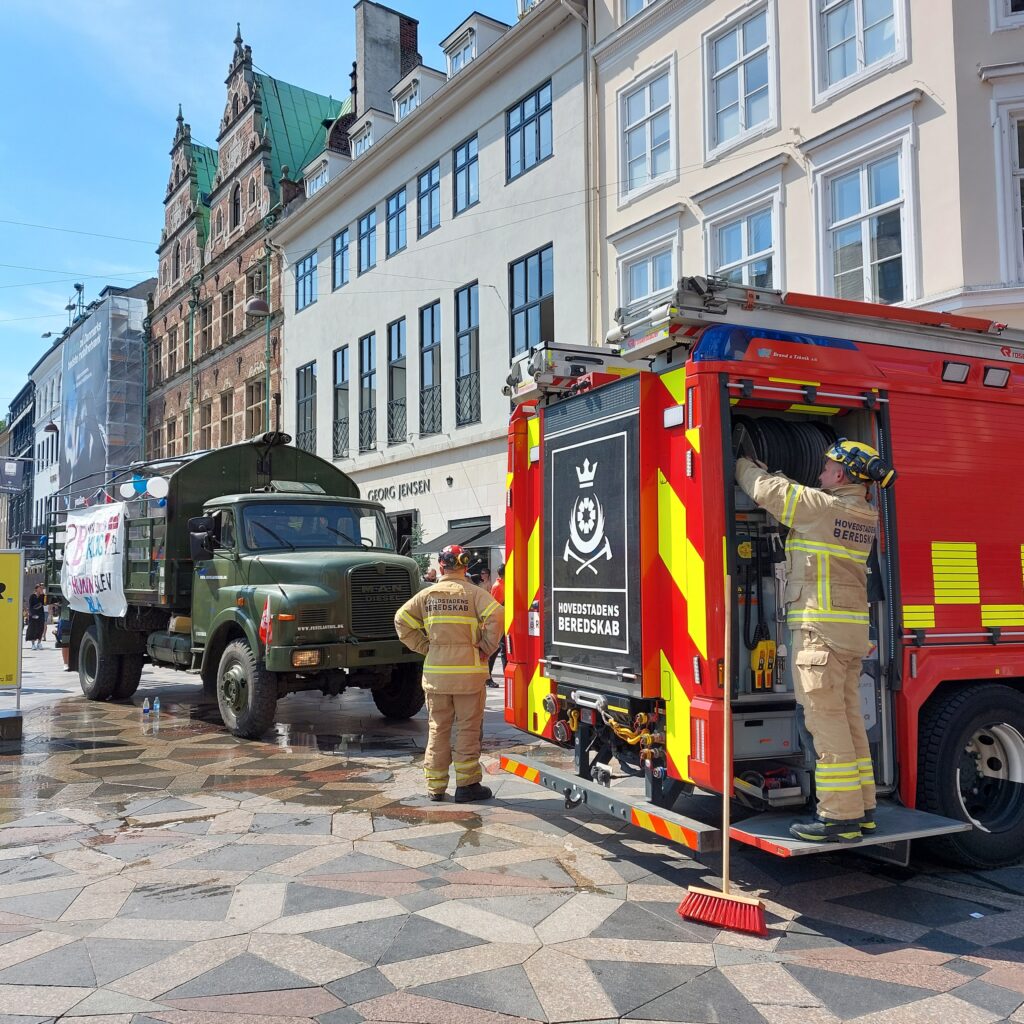
Strangely enough, we heard no one singing ‘Tri smi kinisiri pi Hibri plids’, but there was enough noise without that. The stork fountain was foaming, so someone had had fun with dish washing detergent.
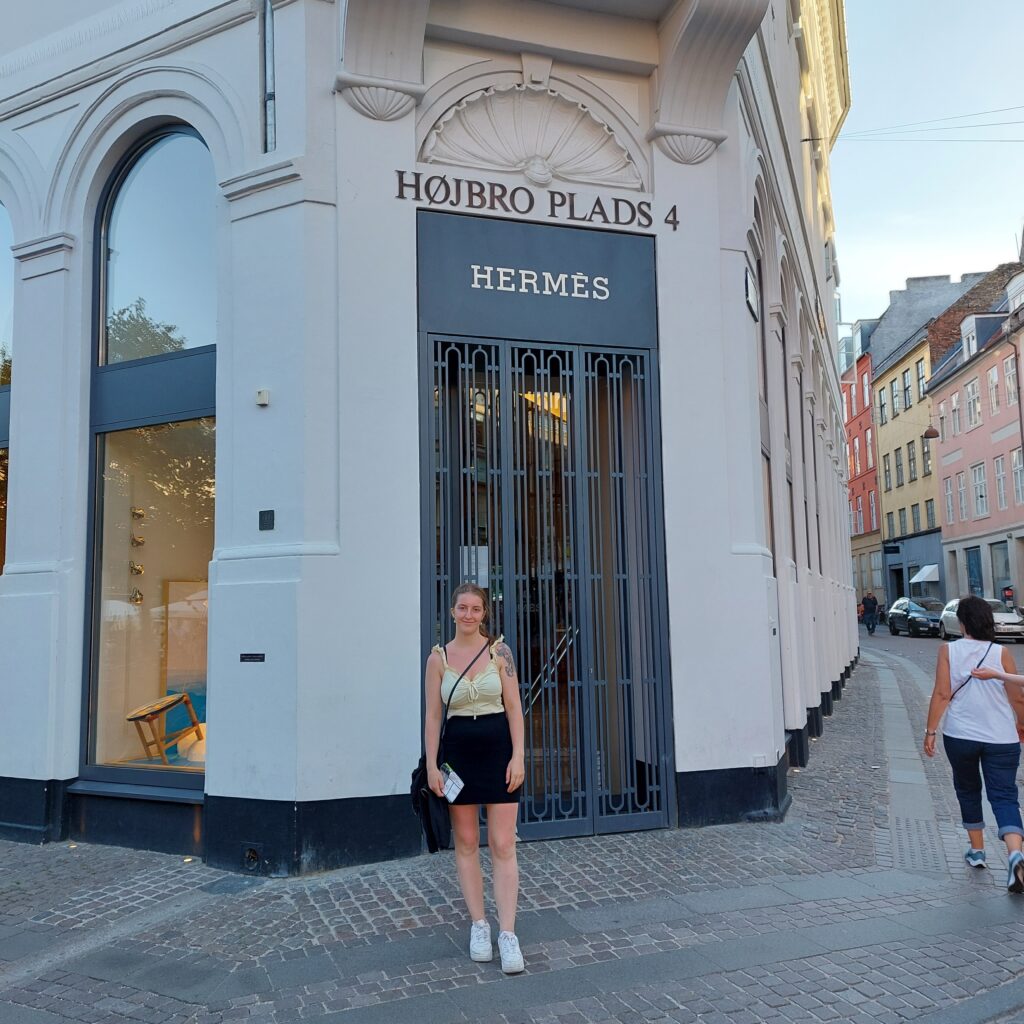
At Højbro (High Bridge) there has been a bridge over to Slotsholmen since the middle ages. Todays bridge is from 1878 and drawn by Vilhelm Dahlerup. But we can’t really say it is very high. At Højbro you can meet The Merman in a sculpture of Suste Bonnén. Under water, of course.

This work of art was given to Copenhagen City in 1992, promising the city would maintain it. And they have – the sculpture was newly renovated.

For this bathing adventure we needed a photographer, our daughter Une volunteered (under pressure). An easy job when the models are as photogenic as this!
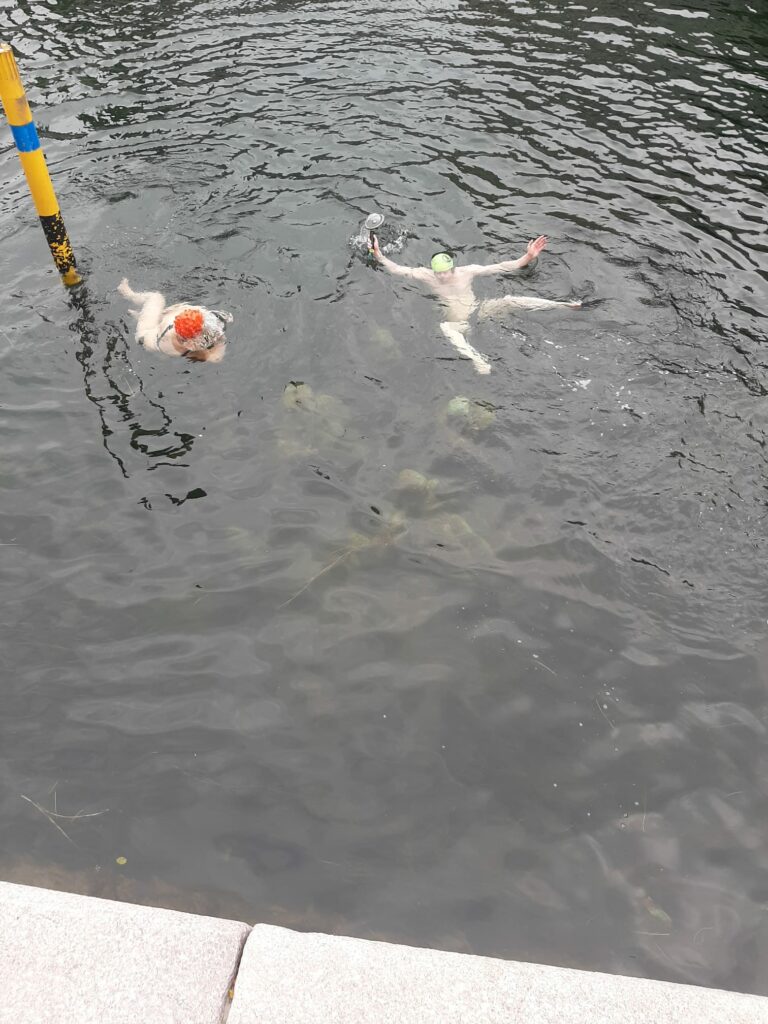
We first planned to jump from the quay for the sightseeing boats, right next to the statues. But there was a sign forbidding anyone not going on a cruise to be there (nothing against bathing). While we were contemplating this, a boat actually came and we realized this was a bad idea. The solution was to use one of the ladders on the other side of Højbro bridge. Idun was a little scared we would be “saved”. But there was nothing to worry about. Hardly anyone took notice of us undressing, climbing down the ladder and going into the water. Only smiling faces and waving hands from the passing boats. And the sculpture? Great!
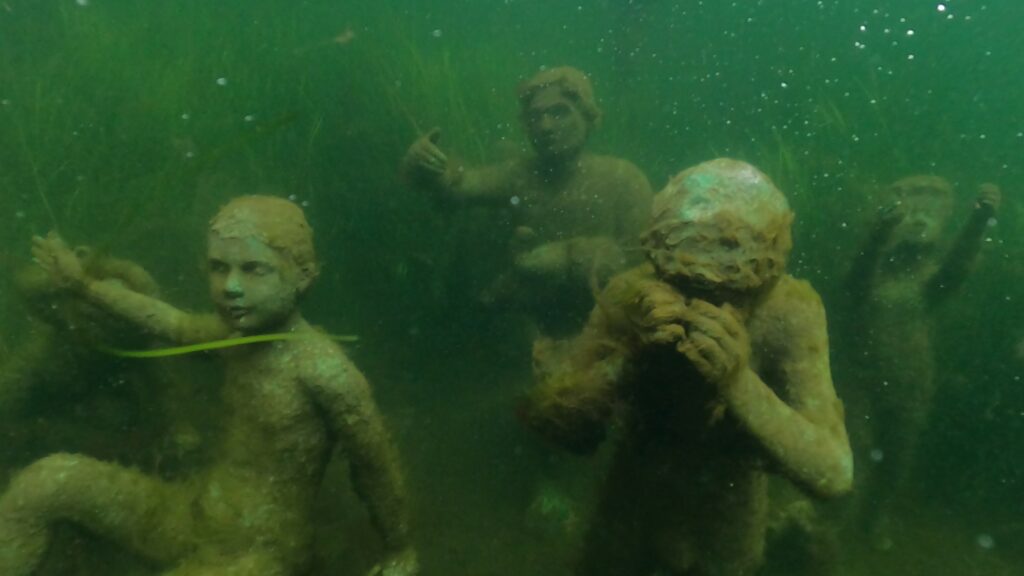
The fairytale about Agnete and the Merman is rooted in middle age ballads, but is a 1800’s folk song. The song tells about Agnete, who falls in love with a merman and follows him to the bottom of the ocean. She lives with him for eight years and bears him seven sons.
One day, when she hears the church bells ring, she asks for permission to go back to the humans world. And she is allowed, but the Merman reminds her that her children will miss her deeply if she doesn’t return. When Agnete meets her mother, she renounces her children and never returns to the ocean (in the most common version, there are many versions of the story and in some of them she does go back).
Her not returning brings great grief under water, and this we think Bonnén really has shown in these bronce statues.

Hans Christian Andersen actually wrote a theater play about Agnete, which became a flop. His later story about “The Little Mermaid”, however, was a hit. It is a plot twist of Agnete’s story. While the human girl Agnete was lured into the ocean by a merman, The Little Mermaid went onto land drawn towards a human man. Andersen dropped the kid part, but also has a really tragic ending (very different from Disney’s version). Outside of Denmark, Agnete isn’t much known and The Little Mermaid is by most people thought to be completely H.C.Andersen’s own idea.
A similar motive we can find in old stories about getting “taken into the mountains”. You could e.g. listen to Gåte’s song about Margit Hjukse. Who takes a quite different choice from Agnete.
So it was time to swim back to the human world again. It was definitely a good time to take a bath with The Merman. The water was clean and clear. Until a boat passed, which had a diesel leak, so we could see stripes floating from it. Not that they seemed to bother much when we told them.
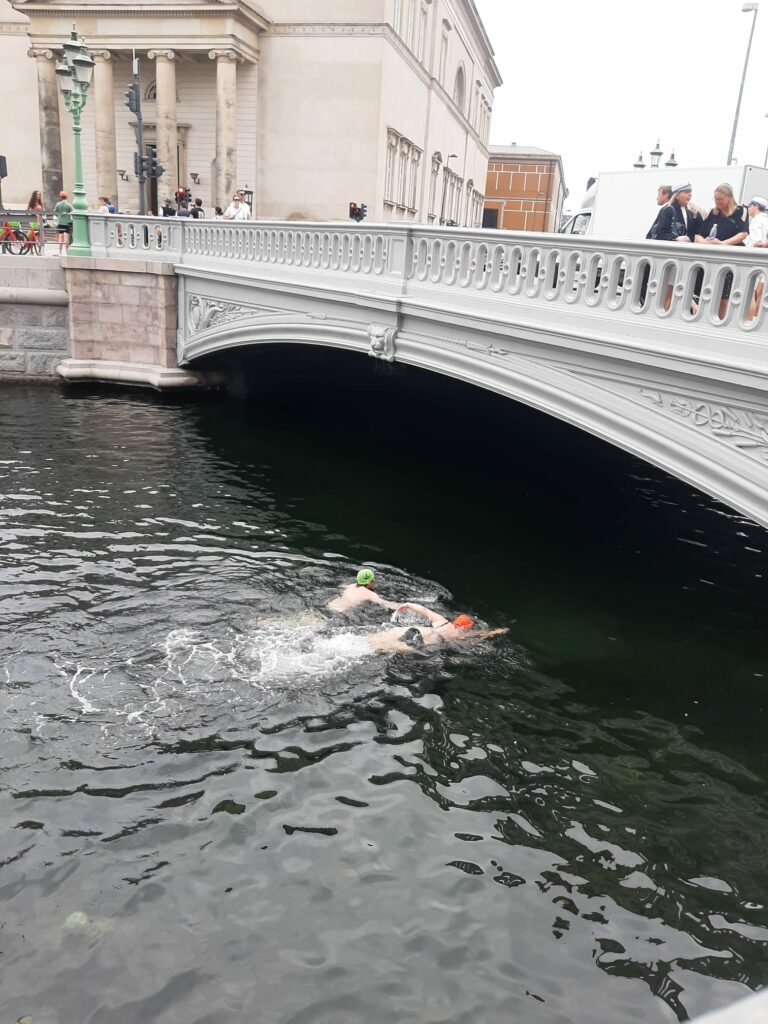
What to do in Copenhagen after a nice bath? We found Tivoli to be a good choice!

Daugava beach
In the western part of Russia, about midway between Novgorod and Moscow, there are some heights called the Valdaj heights. There you can find the source of three big rivers: Volga, Dnepr and Daugava (also called Eastern Dvina).

Daugava is over 1000km long and flows through Russia, Belarus and Latvia before ending in the Riga Bay in the Baltic Sea. There are three power plants in the river. Construction of a fourth has been stopped after massive protests.
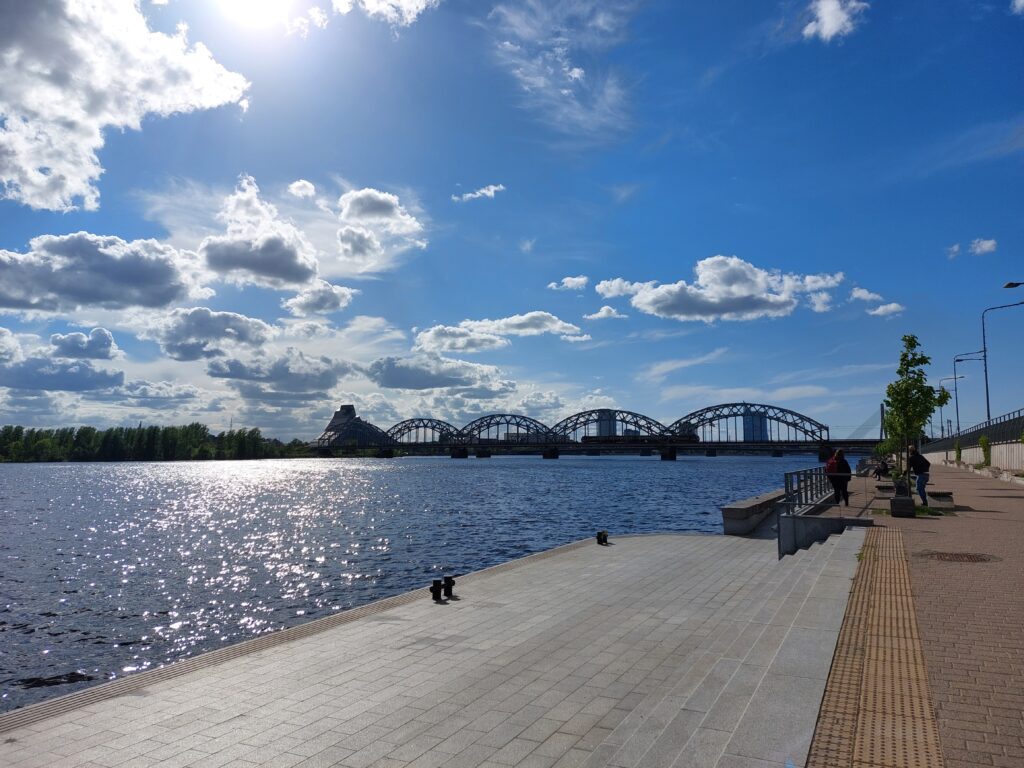
The most important Latvian town was always at the river. Previously it was Ikšķile, 50km further upstream of Riga. The city Riga was founded in 1201, as the capitol of Livland, belonging to the german order. German was the city’s only official language until 1891.
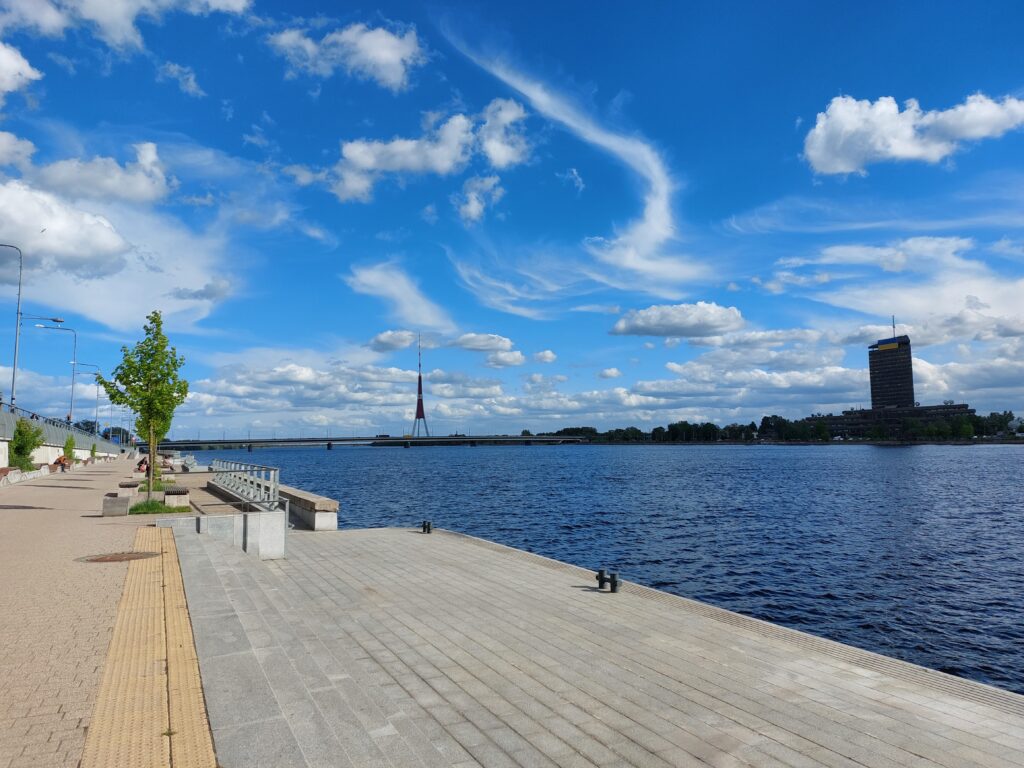
We were in Riga for Knut’s last filming days of the movie ‘Sulis’. So of course we had to ask if Riga has any good places for a bath? The access to water obviously wasn’t any problem. The question was if it really was suited for bathing. We got rather diverging answers to that question. Most people simply said: ‘No! It’s too cold!’. Some recommended nearby lakes. But the tourist office could inform us: Yes, there are bathing places at Daugava – which you can use in the summer (the month of may probably not included as “summer” in her mind). So off we went. As should be obvious, water temperature is no concern og ours if we want a bath.
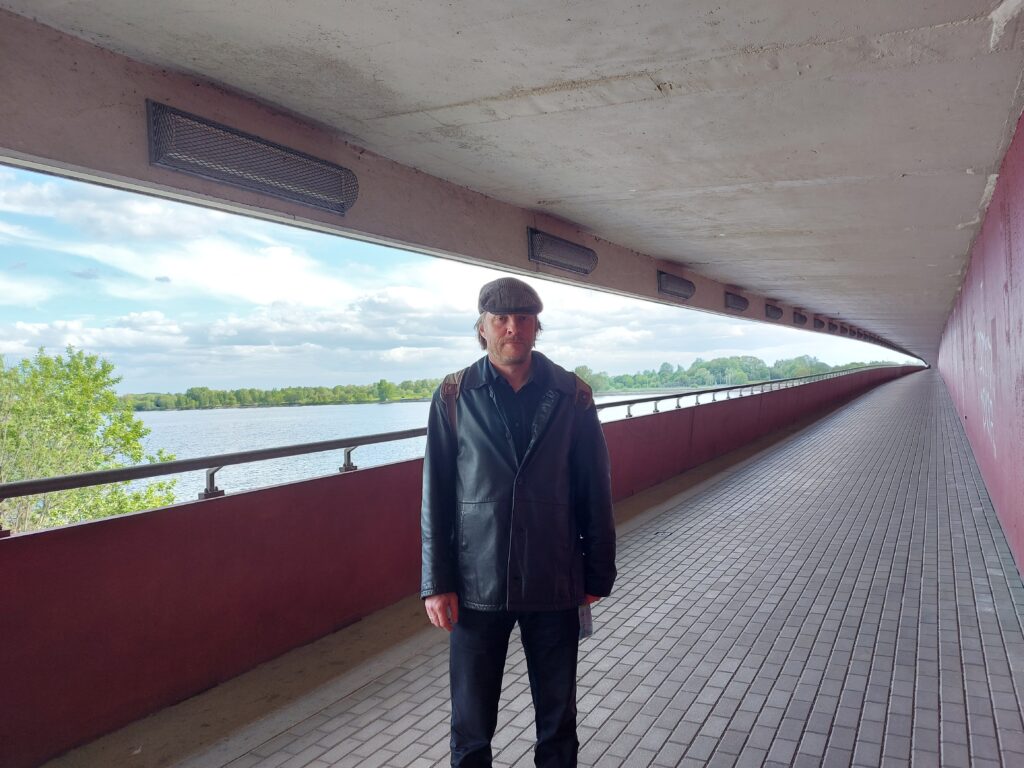
From the old city there is a nice promenade along the river, ever so often with warning signs of ‘No swimming’. We crossed the Daugava on the bridge Salu Tilts. This has a nice concept: Pedestrians and bicyclists have their own level underneath the bridge, separated from the cars. That gives a very relaxed space, although with view only in one direction.
After crossing another small branch of the river, we arrived at Peldvieta Lucavsalas līcis. This is a nice bathing spot with golden sand. Not too crowded at this time of year, either. We spotted one fisherman and one homeless guy as we arrived.
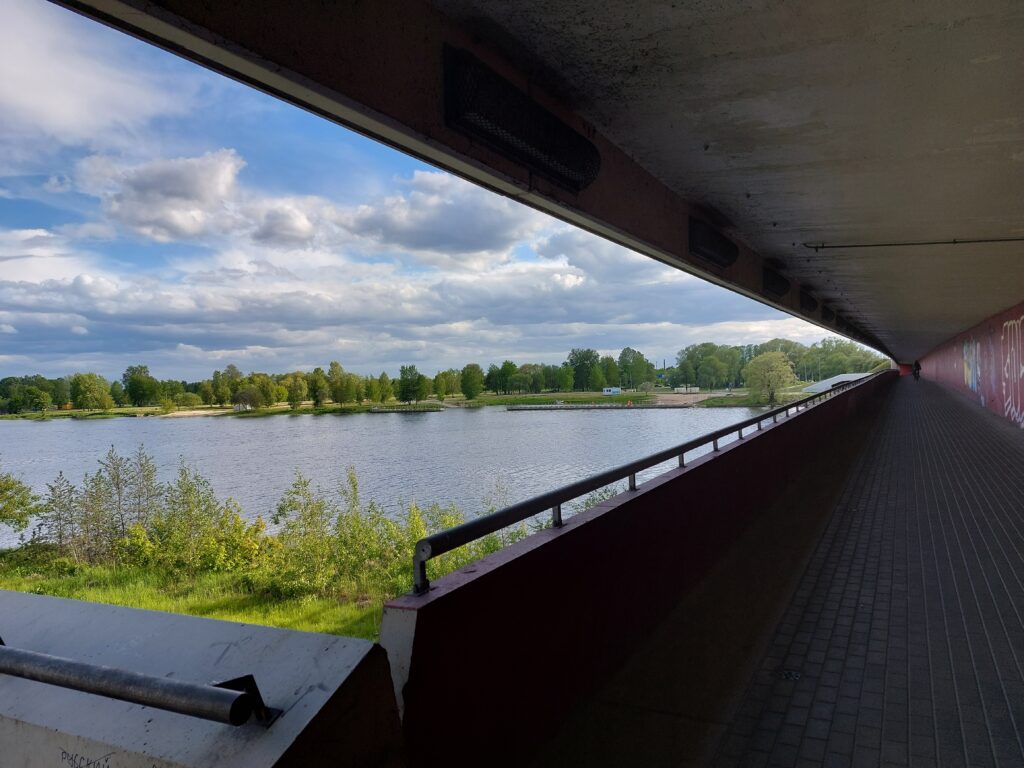
It was a great bath. Sunny, no wind and the water seemed very nice for a river that runs through one of the largest cities in Northern Europe.
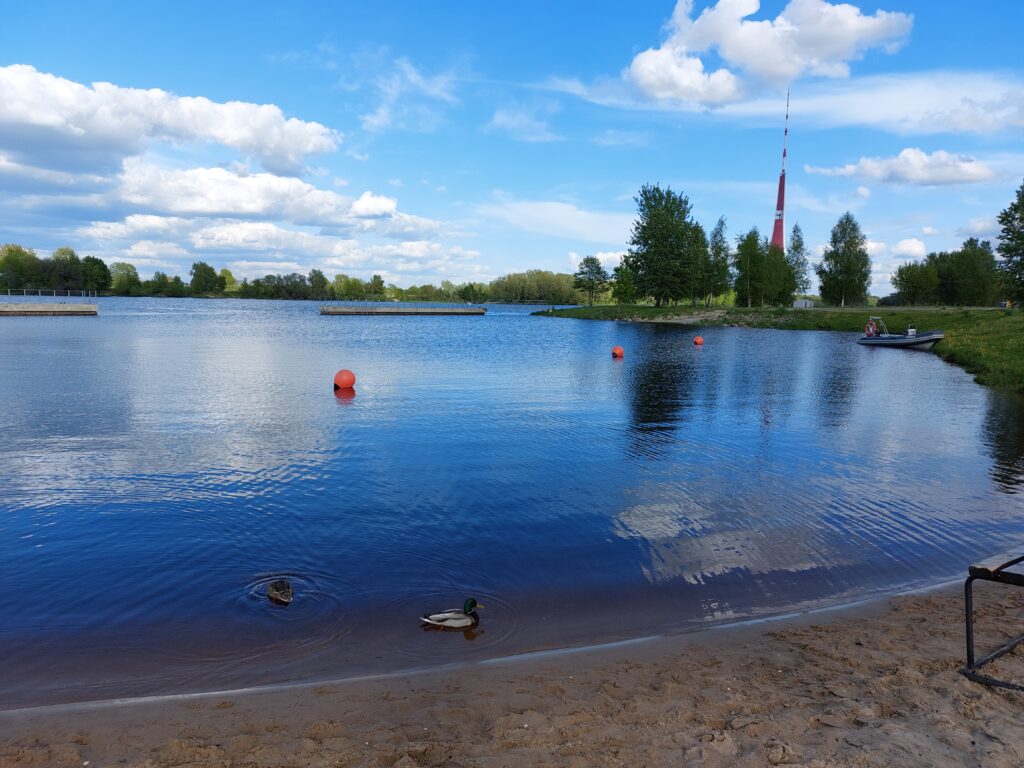
This was definitely a good time for a bath in Daugava!

After the bath is a good time for dinner. We can recommend the restaurant ‘The Good Father’, in the old city.

In ‘The Good Father’ you will find good food and lot of fun stuff to play with. Not for the faint hearted, though, be warned!

The hunt for Lady Kathleen
The big internet had spoken: The search for “Lady Kathleen” showed lots of pictures of the wreckage of “Lady Cotlin”, about 2 km from the lighthouse Mangaļsalas bāka, that gives the way into the river Daugava. The wreck is actually visible in Google maps if you zoom enough!
This just had to be the same Lady? Further searches showed articles with different name varieties, dates and years (both 1951 and 1954 are mentioned) together with wild theories about who owned the ship and why she stranded.
As far as we know, this is what really happened:
The Norway registered ship Lady Kathleen stranded thursday 29/11-1951 at 20:30 after loosing steering speed while trying to connect with the pilot boat in awful weather.

The only woman on board, the telegraphist Kari Herje, 23 years old, sent SOS and hoped they would be saved. Riga in 1951 was in the middle of the cold war. All western people where considered capitalists and potential spies. Would the Sovjet coast guard even try to save them? If they heard the emergency call at all?
After sending SOS a while without response, Kari put the telegraph aside and tried the radio instead. Maybe a radio station would receive her call? There were several stations that used to respond, once she even received a proposal from a radio friend.
Yes! She received an answer: “What’s going on, Kari, are you in distress at sea? Do you want to call your mom?”. Well, yes, that seemed like a good idea, so Kari got to call her mother Margit Herje while the ship was rocking on the sandbank in the Riga Bay.
That is why the local newspaper Adresseavisa in Trondheim knew about the happening before the shipping company! The dramatic events produced a lot of newspaper articles: “Trondheim woman in distress at sea!”, “23 year old lady sent SOS while the ship was sinking!”, and “The wrecking didn’t scare her. Goes out to sea again.” were some of the headlines going around the country towards the end of 1951.

In the meantime, the rest of the crew reacted in a typical Norwegian fashion: They got drunk! There are at least two reasons to get drunk on a sinking ship:
1) It calms the nerves if you think you might be going to die
2) If the ship goes down, there is no point wasting all the alcohol
But yes! They were saved. The Sovjet guards sent a rescue vessel and saved the whole crew. Because of their condition, rumours soon started flying, about the ship beeing stranded because the seamen where drunk. The crew were lodged in a hotel, all on the same floor. And in the hallway: A lady on a chair, making sure no one left the place. That was OK for the first days. The crew needed to sleep things off and they got served food. But they weren’t allowed to leave the building. Norwegians were enemies in the cold war.
The third day one of the seamen got enough of this: “I’m going to town. NOW!”, “With or without that damned woman!”. Then all of a sudden they had arranged sightseeing in Riga with a bus. How thrilling! But as they passed the railroad station, Kari started to wonder. Something felt wrong. The mood. Lots of people, but no joy. A lot of luggage with kitchen utensils and everything. Where were all these people going? “They are going on vacation!”, was the answer they got. Many years later Kari understood that these people were being transported to working camps in Siberia.
Now that we knew the wreckage of Lady Kathleen still exists, we just had to take a new trip to Riga Bay, this time to the east of the river Daugava. The plan was to take the train to Vecāķi, but we missed the station and departed in Kalingale instead.

At this point we started to feel that our vacation was a little off the beaten tourist track. Idun wanted to use the expression ‘off-pist’, but Knut insisted that since there were tracks, we were: ‘off-road’, not ‘off-pist’.

After 20 minutes of walking in a high high pine forest, we finally found the ocean. And yes! There are miles and miles of beaches on this side of Daugava as well. We walked along the beach about an hour. The Baltic sea isn’t really crowded at the end of may, but we did meet a few souls. Some walking their dog, some training with or without music in their backpacks, and a few treasure hunters with sticks: Looking for shells or amber.

After about half an hour (about where we would have been had we departed on the right train station), we saw a big rock in the ocean. Could it be the Lady? Is she really still there, after such a long time?

Yes! The remains of Lady Kathleen are still visible, 72 years after she stranded. She is getting a bit worn out, but still hanging in there.

Time to start swimming! Lady Kathleen is popular among the birds, but the comorans left the ship long before we arrived. The only life we saw where lots of sand flies. The water was very dark and we couldn’t see anything below the surface. But we got to touch the wreck. This was a strong moment for Idun. With another outcome of this event, none of Kari’s five children had been born.

Of course we swam around as well.

Back on shore we were colder than we had expected. There were 230m to the wreck and the water temperature was around 12 degrees Celsius. Both felt cold in the beginning of the swim, but then we got used to it, and everything felt OK until we started getting dressed again. Then we realized the fingers were rather stiff!
So we warmed ourselves with another toast to the memory of Kari.

Since there were many varieties of the story online, Knut relieved his inner detective and started searching for the truth. Which brought him to this building in the forest at Sognsvann in Oslo:

The binder was ordered online and waiting when he arrived:

Aside the official wreckage report, there was a lot of correspondence around who was going to pay for the crew staying in Riga and the transport home. Kari described the train to Finland as rather simple – type cattle wagons. One danish crew member “went berserk while drunk” and destroyed everything in his hotel room. The Sovjets sent a demand of 11 113 rubles for ruined inventory, which the shipping company didn’t feel responsible for. According to Kari, several of the crew members went rather crazy, pooped in the stairs and harassed the personnel. Maybe the demand wasn’t too high anyway?
Strangely enough, the official wreckage report mentions both Friday 28/11 and Friday 30/11. From other documents we are quite sure that the Lady stranded Thursday 29/11 and that the crew were saved on Friday 30/11.


We have really enjoyed this process, both finding the wreck and the papers telling the history of what happened. Never too late to do research about Lady Kathleen!
Lady Kathleen’s destiny
Late autumn 1951, November 29th, a full storm hit the Baltic sea. The 2400-ton ship “Lady Kathleen” was on it’s way to Riga with ballast, to load up with salt. With low visibility and high waves the captain lost steering speed while meeting the pilot boat, the Lady stranded on a sandbank and broke in two parts. This was where the river Daugava goes into Riga Bay, only 250 m from land. Lady Kathleen was made in 1943, of armed concrete, due to the severe lack of iron during the second world war. She had water proof bulkheads and couldn’t sink – according to the producer.
Did you ever hear the same claim before, that a ship can’t sink? A general rule might be this: If you build a ship of materials which has higher density than water – she can sink. And concrete has much higher density than water!

In the chaos of the storm, panic was growing aboard. “We are sinking! Everyone to the life boats!”, one seaman yelled. “No!”, the captain shouted back: “No one goes into the life boats, they will be crushed against the ship’s side!”. “But we are sinking, we must try!”, the seaman insisted. Thus the captain gave orders to release an empty (!) life boat.
The crew lined up, ready to enter if things went well. Kari said: “Women and children first!”. She was the only woman aboard, working as a telegraphist. Suddenly she felt the captains hand on her shoulder: “The telegraphist and captain last – you have to go in and send SOS!”. So she did. In the meantime the captain was proven right, one empty life boat was smashed against the ship and the seamen just had to wait for the weather to calm down.
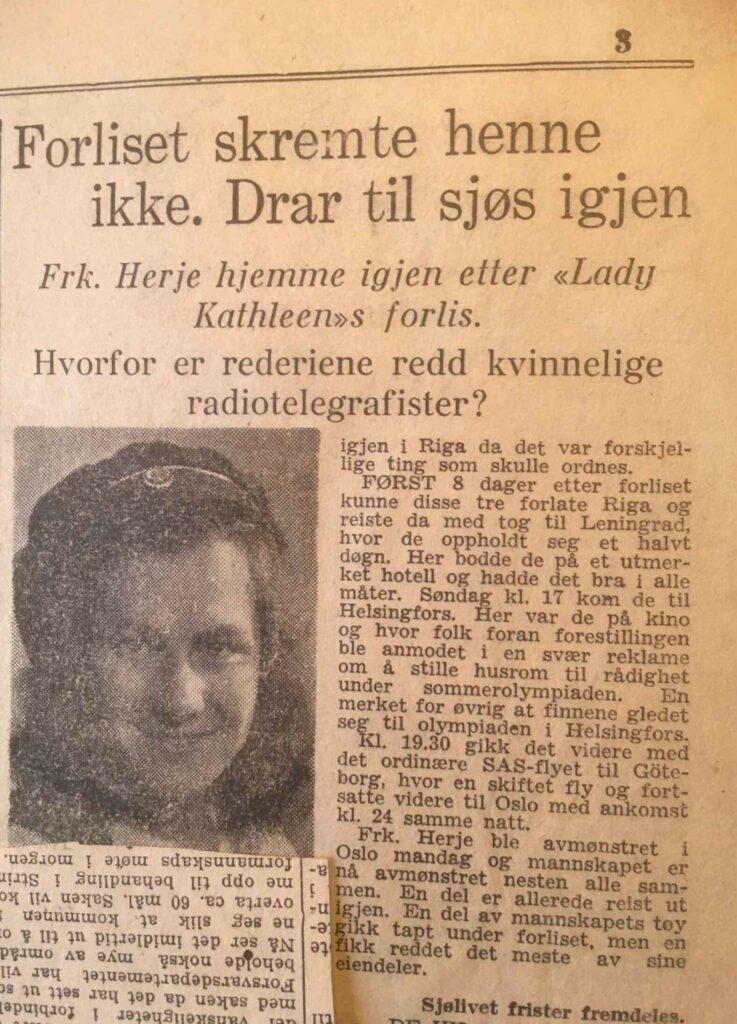
Among the panic struck crew there was one who kept a clear head. He had been a nervous wreck for six years, having survived torpedo attacks three times during the second world war. It’s hard to understand how he survived at all! But here he was, in Riga Bay 1951 in a full storm on a broken ship. All these years after the war he had been waiting for the next torpedo. Always on guard, always with his suitcase packed, always nervous – surely it was only a matter of time before the next attack. When catastrophy was a fact and the other seamen panicked, he found peace for the first time in years. This was exactly what he had been waiting for! His suitcase was ready – he grabbed it and asked: “Where are the life boats?”.
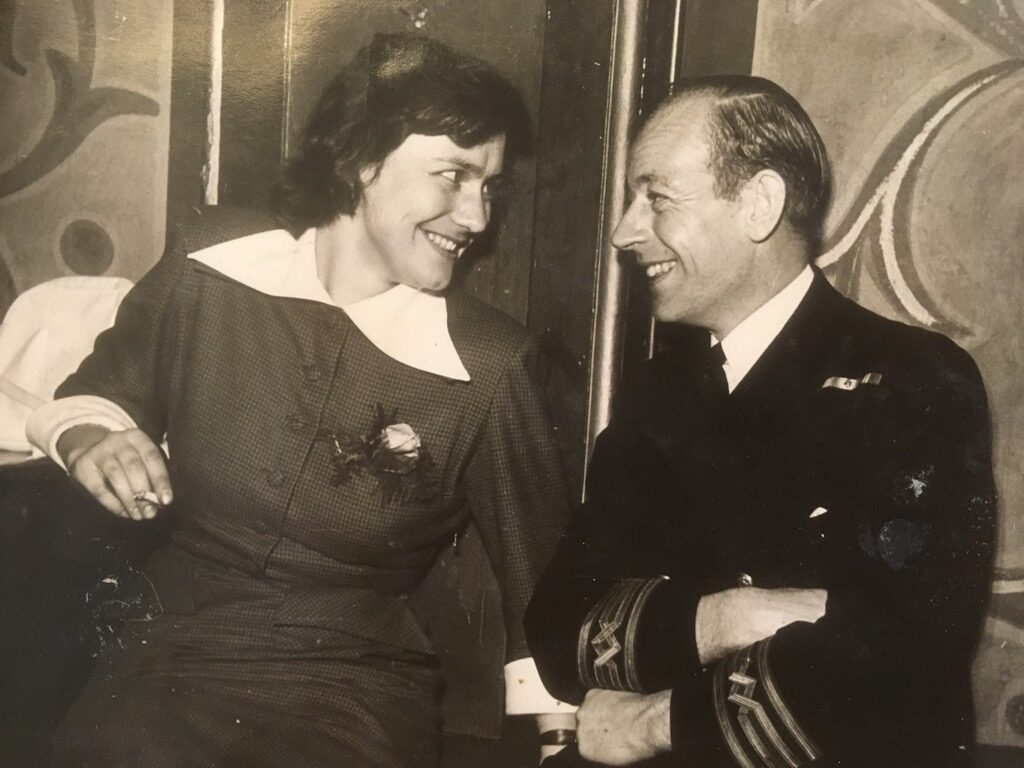
Inspired by these dramatic events, we wanted to go north of Riga (since we were there anyway, to finish the last filming of “Sulis”) and take a bath in memory of Kari Herje – Idun’s mother, who experienced this shipwrecking. It takes about half an hour with train from Riga to Riga Bay. We went to Jurmala, which is a highly recommendable beach paradise!
“Jurmala” means “By the beach”, quite suitable. The town has a population of about 50 000 and around 33 km beach. Quite a lovely village, with lots of villas made of wood or stone. Some of the houses have towers of different sizes, almost like small castles. There are also spa hotels, which we didn’t visit this time.
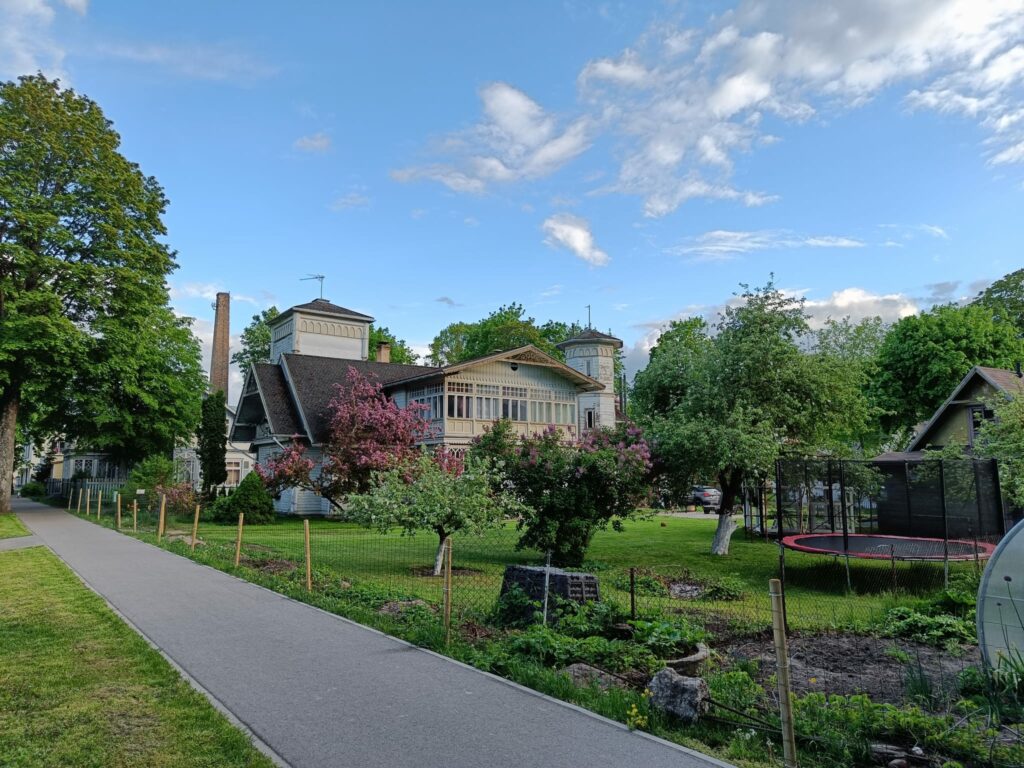
Between the town and the beach there are high forests with pines and birches. We can’t remember having seen such high birches anywhere!
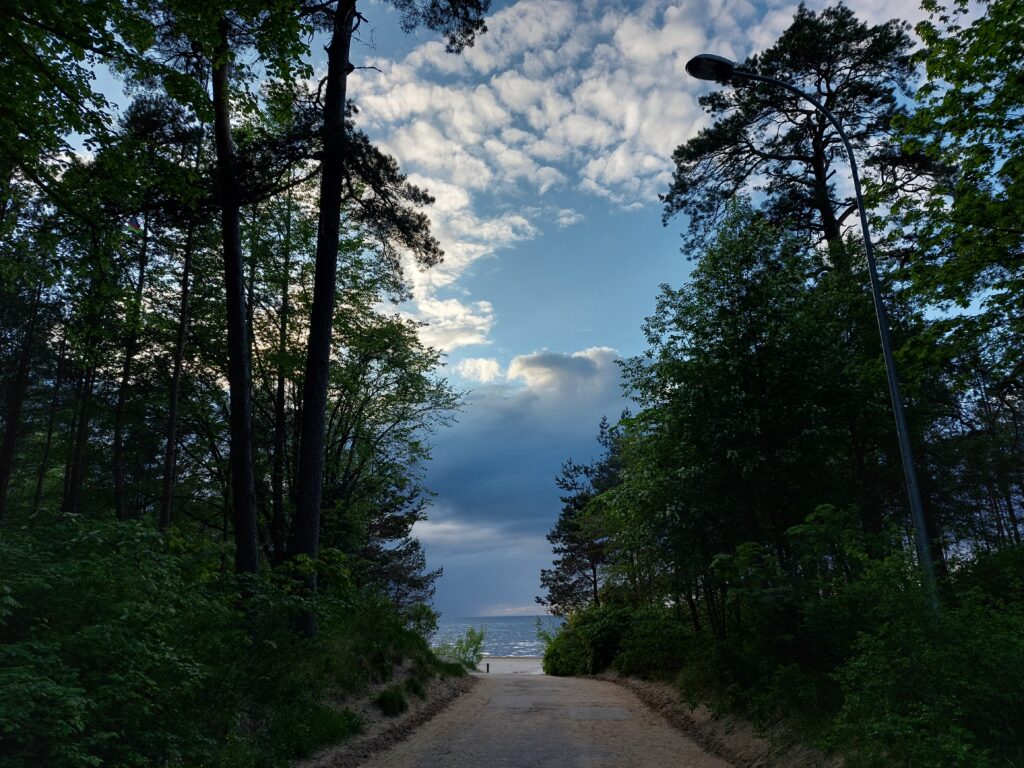
Riga Bay consists of kilometer upon kilometer of golden beaches, and once in a while, but not too often, a beach bar. In the times of the Sovjet Union, Jurmala was one of the favourite places of Leonid Bresjnev and Nikita Krustsjov (no, we didn’t find his shoe anywhere).

In Jurmala it’s obviously a good time for a bath! Swimming exercise is also possible, just keep a suitable distance from the beach.
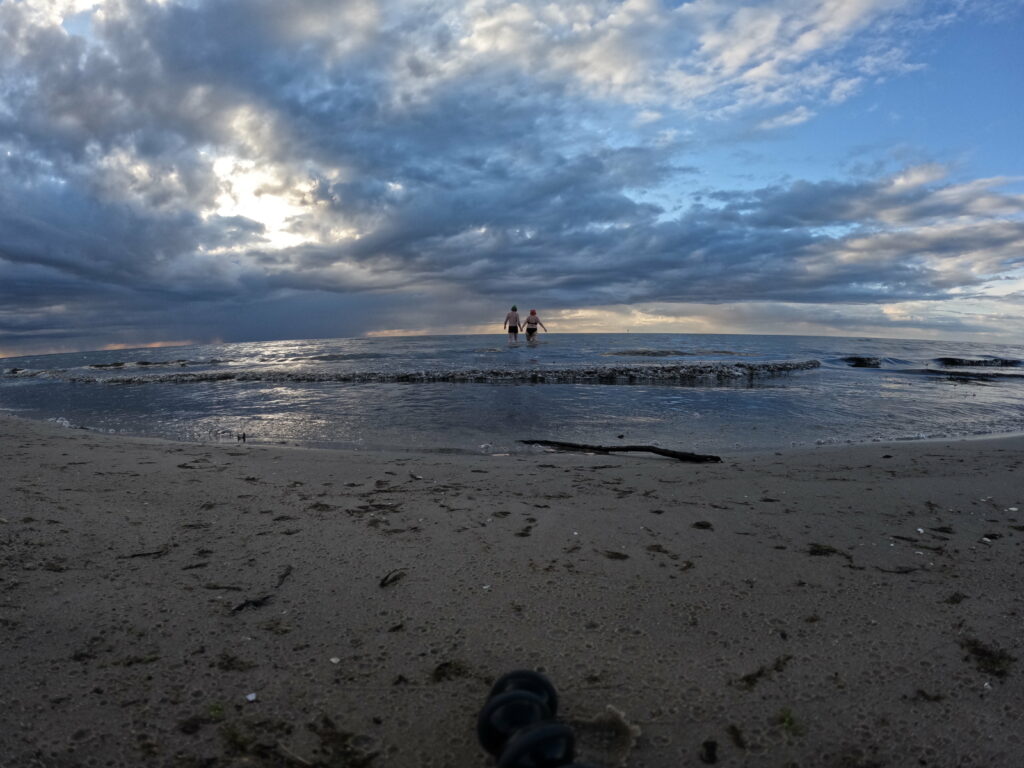
No homage to Kari would be complete without a sharp drink. This time not her favorite Lysholm Linie Akevitt, but the more local Riga Balsam.
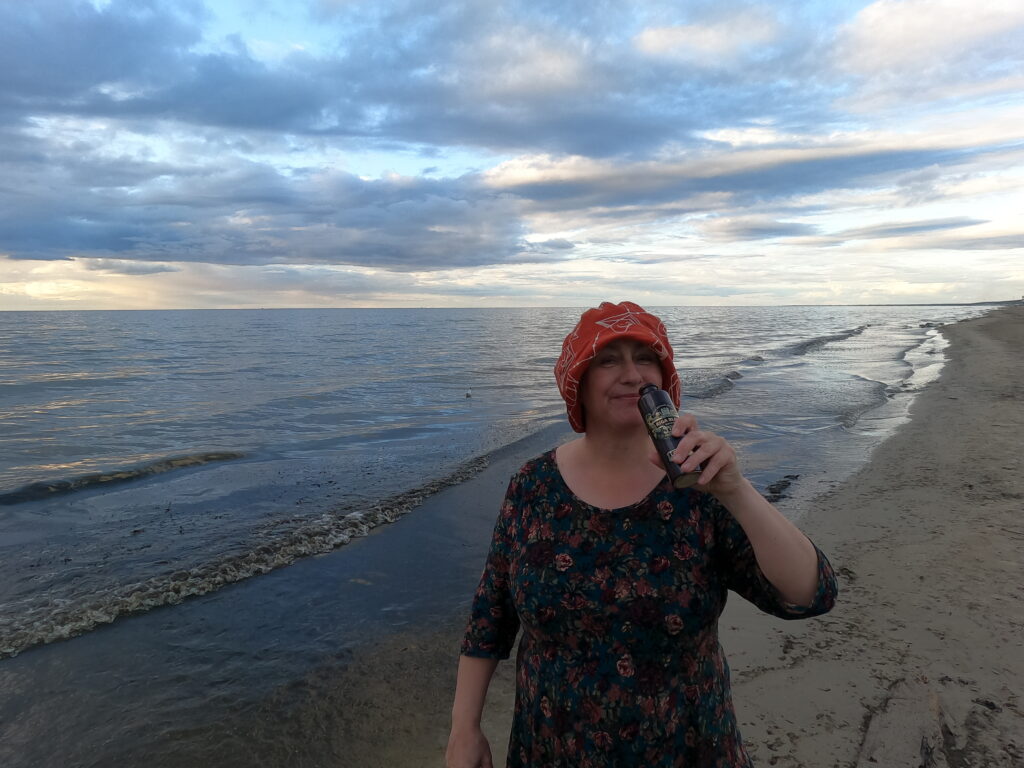
The train trip home was a good time for googling – maybe the ‘O grand internet’ could magically dig up more information about Lady Kathleen? These searches gave plentiful of interesting results! To be continued…
Everyone hates Johan
When reading about how countries/cities/towns should make things easy for movie makers, there is much talk about all the tourists who would come to the places where a movie is shot. In that way, the location should earn money, even if the movie is sponsored for selecting that particular location. If this really happens, is debatable. Especially when e.g. the Norwegian “Prekestolen” (close to Stavanger) in “Mission Impossible” is presented as being in India!
Few might have thought that the movie “Everyone hates Johan”, shot in Titran on the island Frøya, would bring any tourists. But we can confirm it now has happened! Knut was an extra in the movie and was one day on Frøya recording a while ago. When the movie finally came to the movie theaters, he didn’t see himself until his name was in the credits. That’s what can happen when you are an extra!
No matter, we liked the movie very much and suspect it is closer to the truth of how it is to live on Titran than the natives would care to admit. So we just had to take a bath in Johan’s foot steps.
What we had planned, was a bath in the sound right below Johan’s house, where his parents lost their lives. This is right west of Titran and is called Svalbalen beach (originally Svalbar, from “Sval”, meaning chilly). What we hadn’t considered, was the tide. We arrived Titran friday evening and went straight to the beach, but quickly realized that at low tide it looks quite different than in the movie. So we went back the next day on high tide instead and then it looked just right.
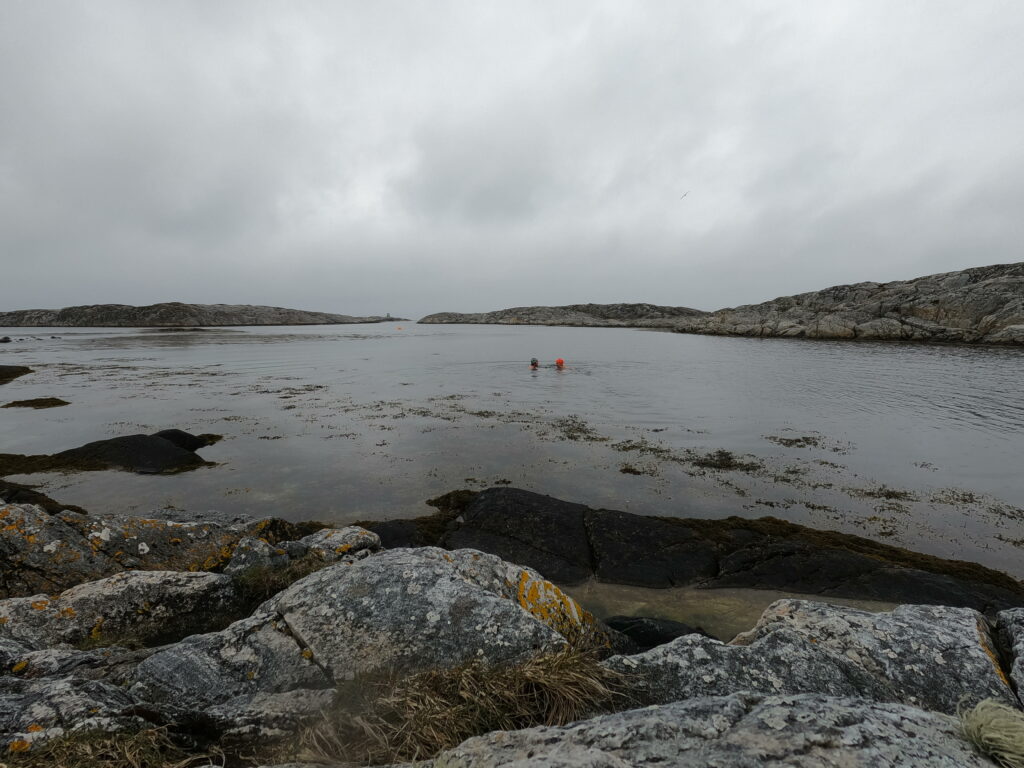
The houses of Johan and his childhood sweetheart Solvor, whom he happened to blow up a little, are close to the beach, just as the movie depicts it.
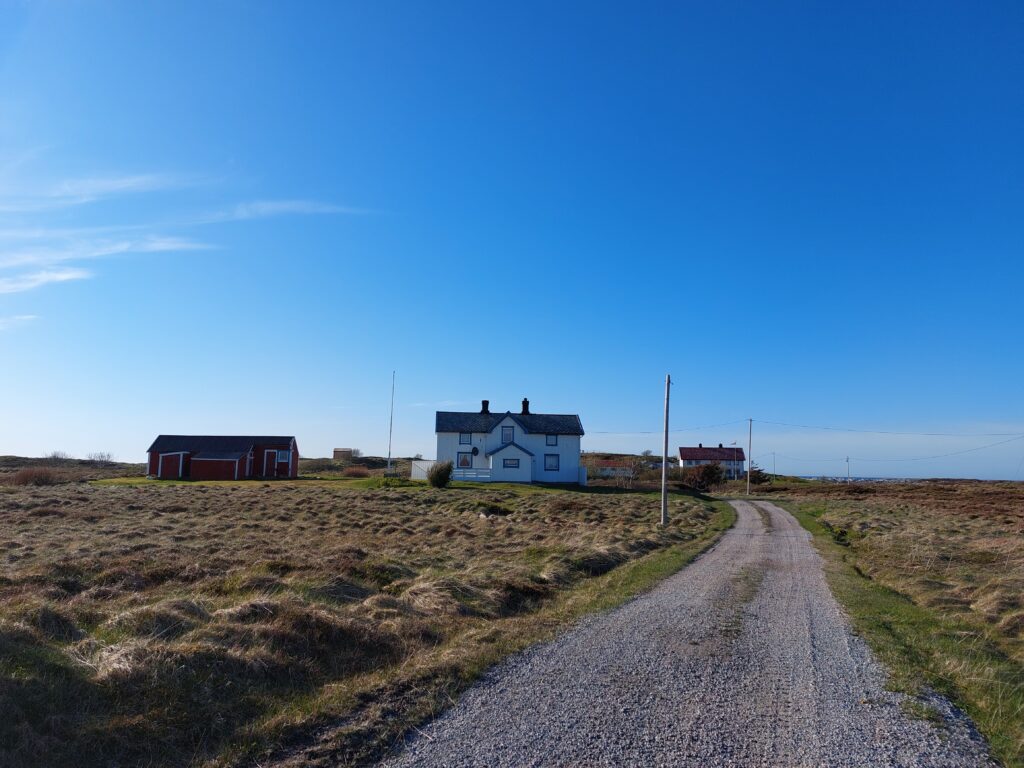
At the beach there is now a house for bird watching. Very nice and very new, but maybe a little too far from the beach for misusing it to change before bathing.
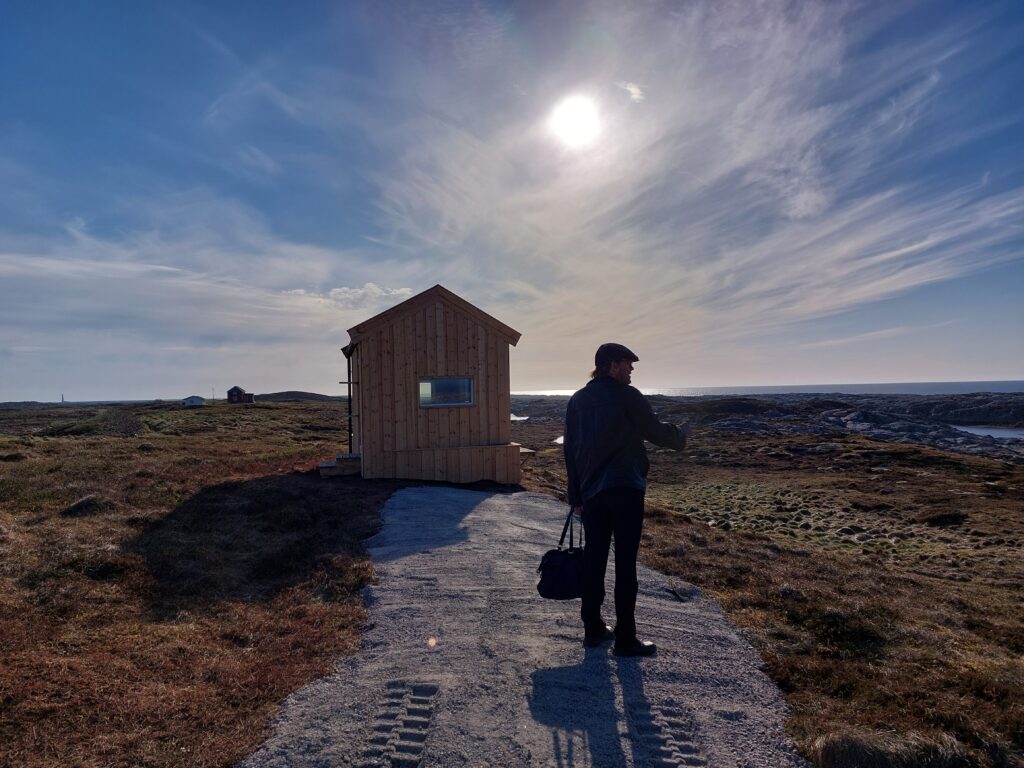
Without knowing for sure, we suspect that this house has a direct correlation to the movie, since it was brand new. Maybe financed by money someone got for renting out their house for filming? Actually it was so new that we were the first to sign in the guest book! Which was a first for us.
One thing we hadn’t thought about, is that there are other central elements in the movie to see around! E.g. these bars where Johan showed his strength.
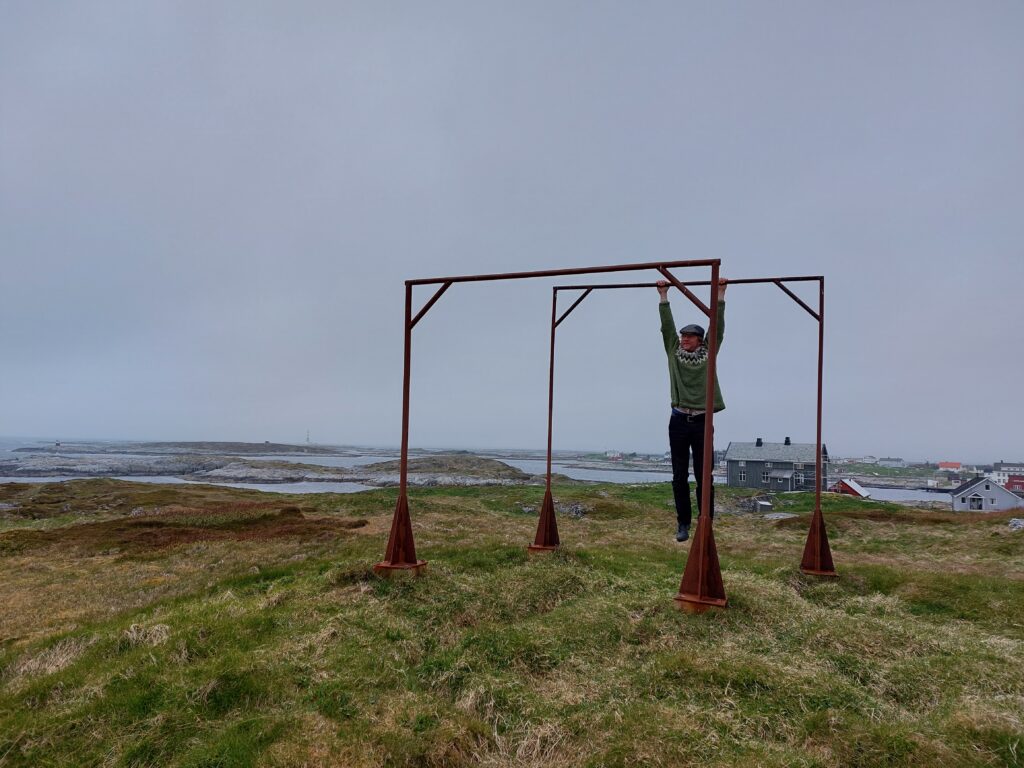
Also Sletringen lighthouse was in the movie, but that’s another story. Our conclusion is that a bath in “Johan’s bay” is just right.
National bath
After the young ones have left the nest, we haven’t watched the traditional children’s parade on the Norwegian national day of May 17th, but taken a hike instead. A couple of years we went on top of Storheia, Trondheims highest mountain. This is a nice little trip, with only a short walk down to town afterwards (easily combined with a bath at Sjøbadet). But after the city was joined with the neighbouring Klæbu in 2020, Trondheims highest top is now Kråkfjellet and much less accessible.
So we took a shorter option, went by bike to Bekken gård and walked up to Estenstadhytta. The cabin wasn’t open for serving, but we knew that and had everything we needed with us!

Of course we also wanted a bath and on the way down we went by Estenstaddammen. Trondheim was blessed with phantastic weather, so we don’t believe anyone was shocked that we cooled ourselves down a little.

In Norway there has been much debate lately about our national costumes not being suited for people not comfortable with standard stereotypes like male/female. So we tested a switch.
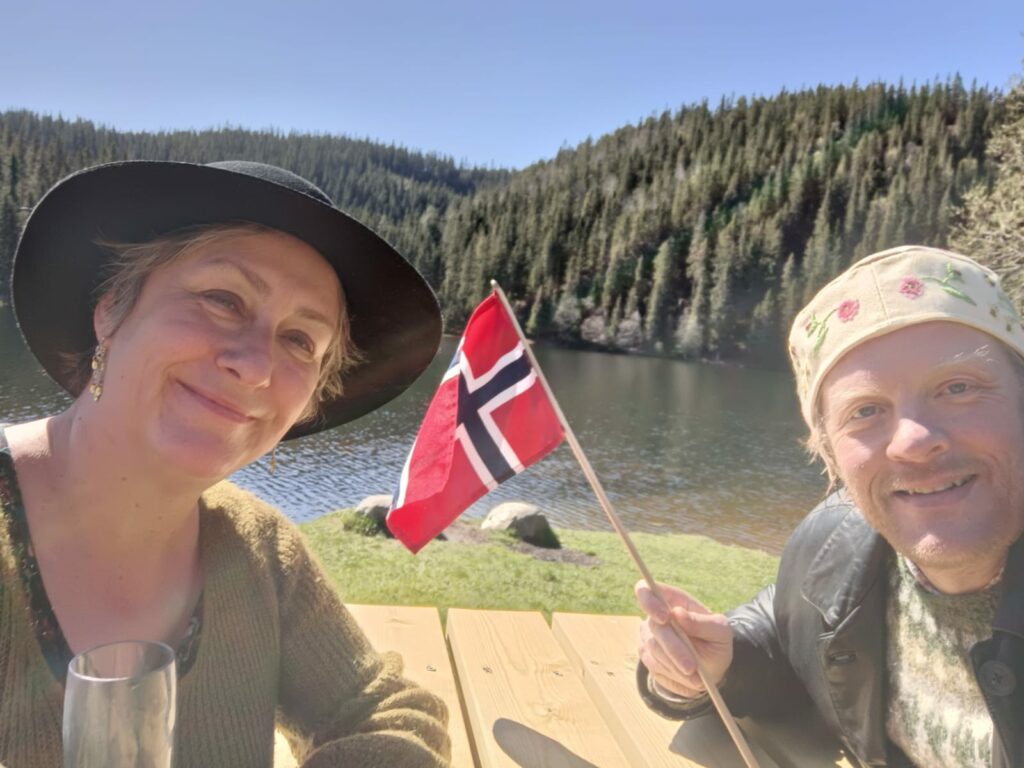
No doubt that a bath is the right thing to do on May 17th!
Telegraph Bay
Tromsø’s city beach is on the south tip of Tromøya (Trom island). We parked at the old aquarium, a starting point of nice hiking paths along the ocean. The old aquarium opened in 1952 and collected salt water from 25 m depth so the animals could have the same environment as in the sound.
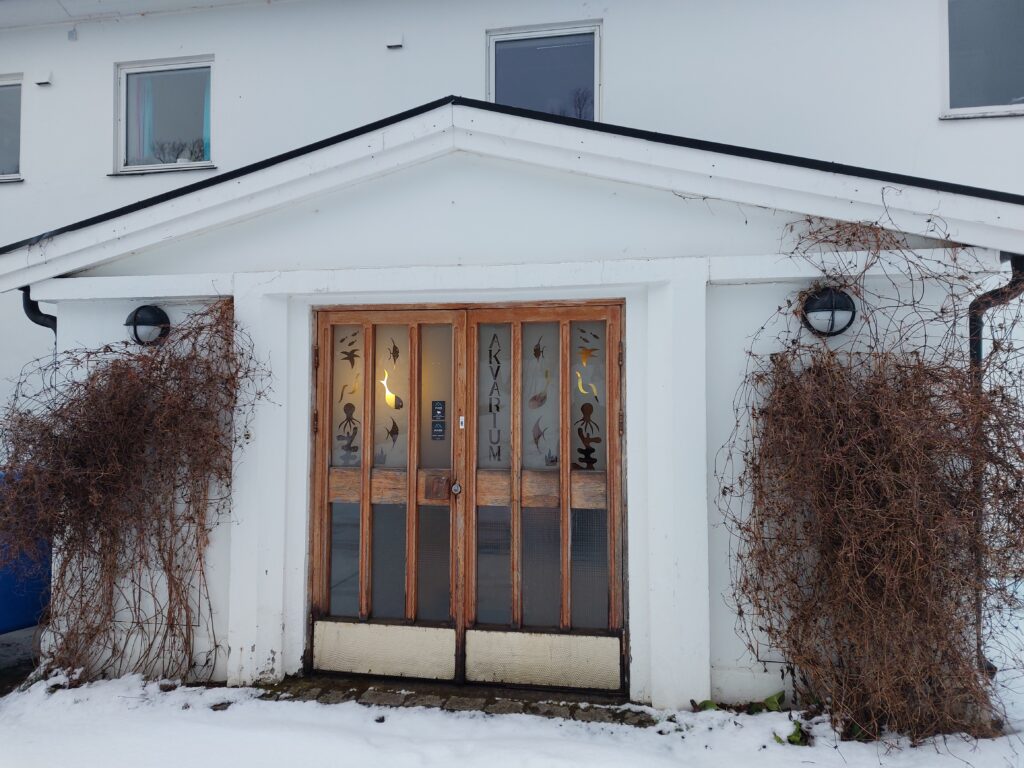
For a period Tromsø Museum had not only seals and reindeer, but also polar bears in Telegraph Bay: Binna and Pelle (mother and son). It is said that they loved biscuits, but the main food was fish. In 1954 they escaped and started swimming towards Grindøya on the other side of the fjord. After a wild hunt they were recaptured and the police ordered them killed. And that was the end of the zoo in Telegraph Bay.
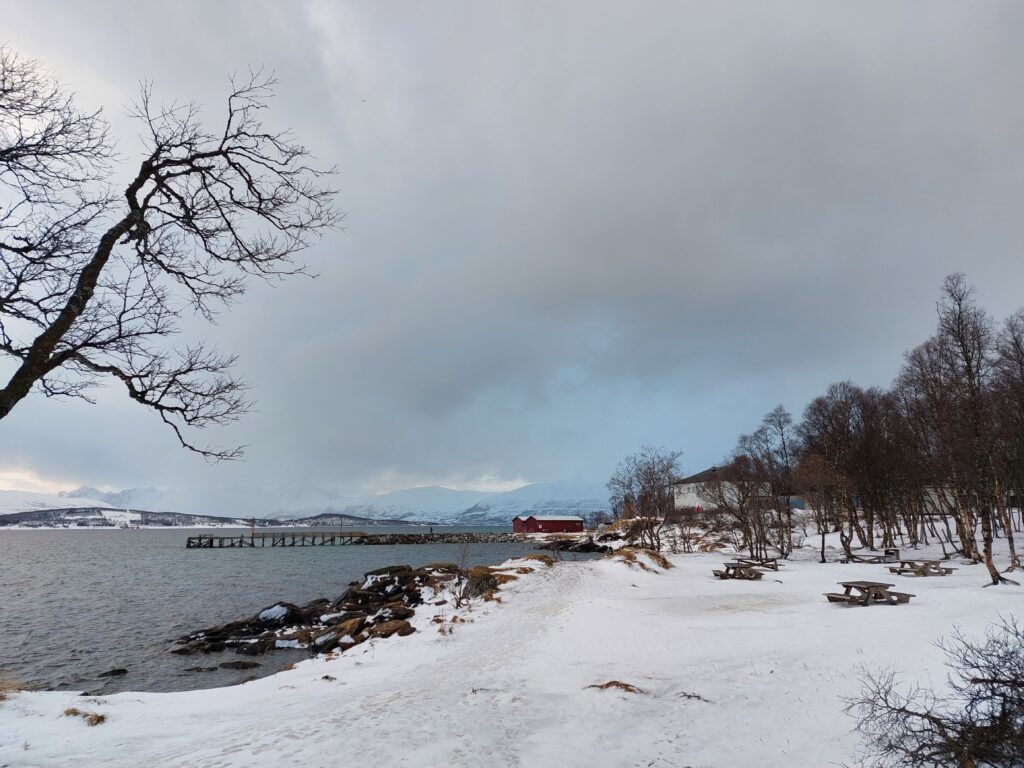
So we felt quite safe as we went for a test swim. The bay is named after a sea cable layed across the fjord to Tisnes in 1894. The cable house still stands and gave some shelter from the rather icy winds while we were changing.
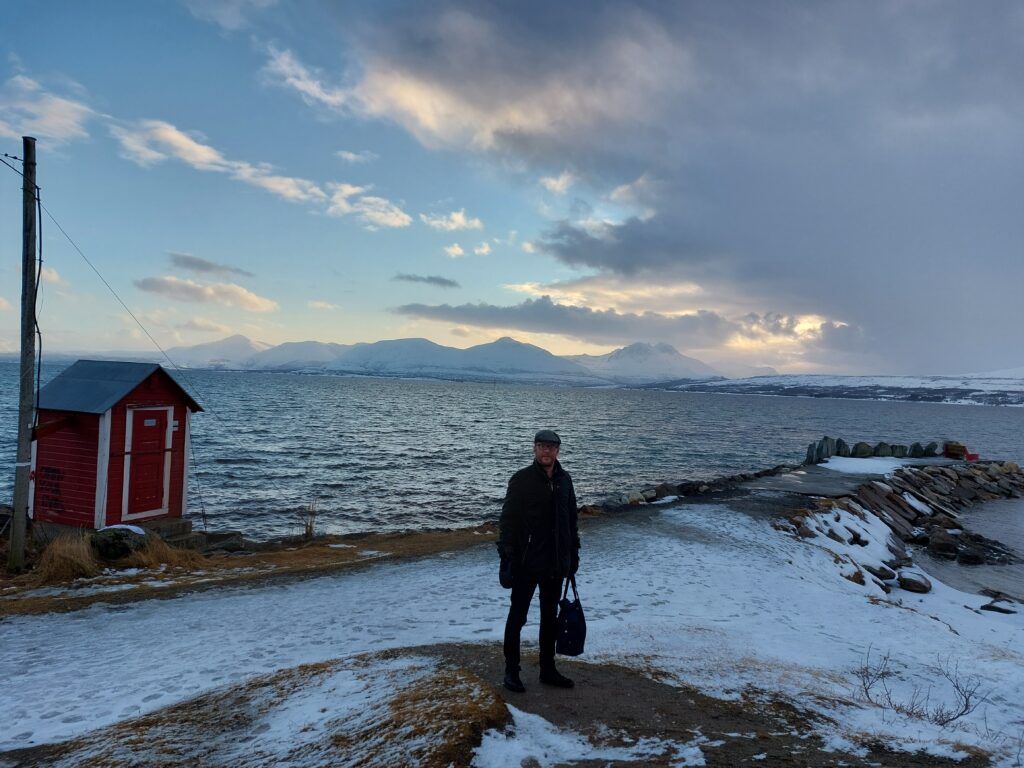
Corona had loosened it’s grip, so there were quite a few people on the paths taking pictures of the beautiful mountains on Kvaløya.
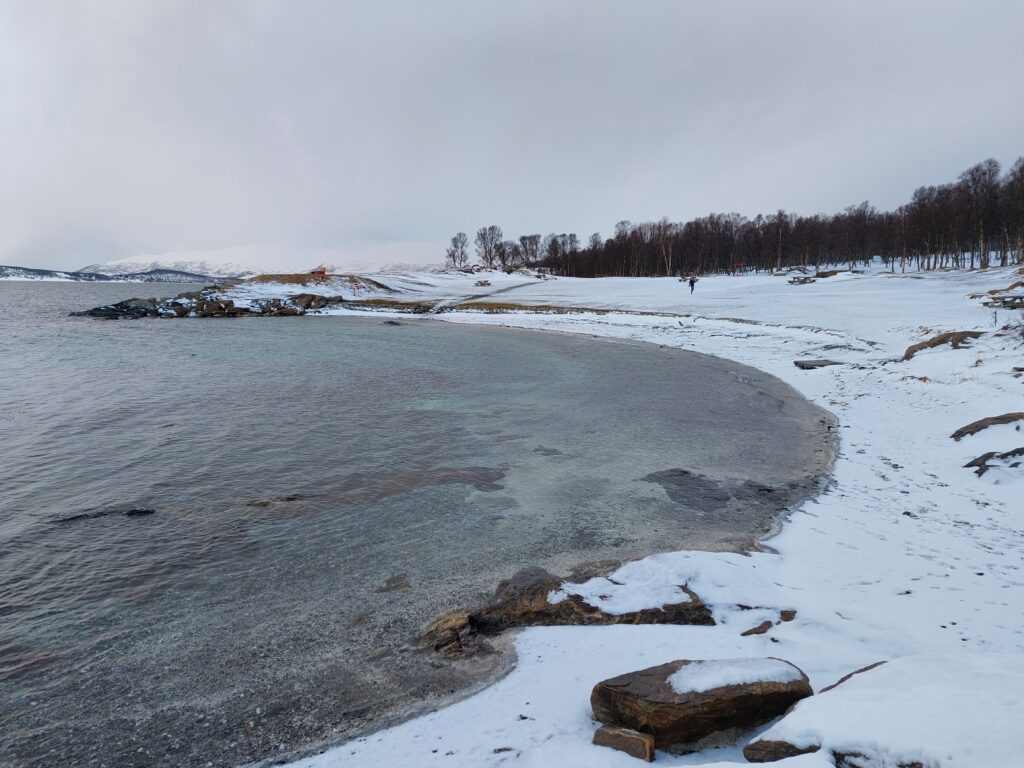
For their sake we hope they had better luck with the equipment than we had that day! Our GoPro totally failed us, so we got only 4 pictures from the bath instead of 1 each second. We now have 2 GoPros, and a tripod for mobile, so we can assure getting at least some useful pictures from future baths.
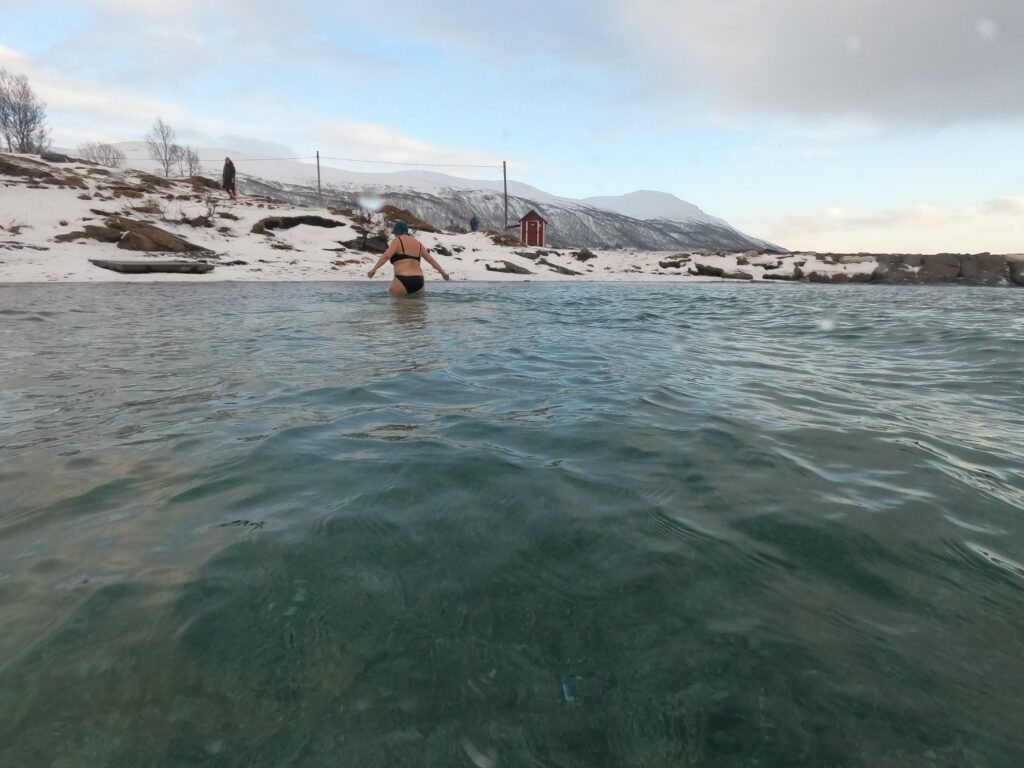
But a nice, fresh bath it was. Right now is a good time for a bath in Telegraph Bay! Next time we go there, we’ll get some better pictures too…